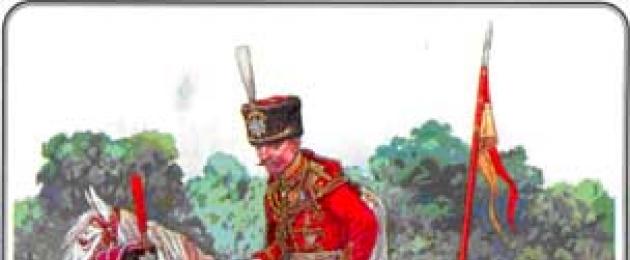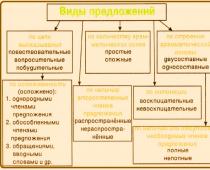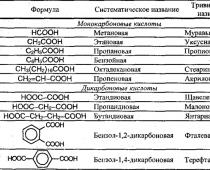Service in the Guards cavalry was very expensive for officers - all uniforms, equipment and horses were purchased by them at their own expense. G.A. von Thal wrote: “The uniform (...) was very expensive. The officer's coat was lined with beaver and the ceremonial beaver hat cost 5 thousand rubles in gold! I then received 500 rubles a month from my mother, and this was not considered much, but I never saw my salary. It went entirely to deduction. Of course, on top of that, my mother dressed me and paid for my apartment in Tsarskoe Selo, where the regiment was stationed.”
1. Junior non-commissioned officer - trumpeter of the Life Guards of the Grodno Hussar Regiment in full dress uniform.
The pipe is silver, its curtain is crimson, with a silver St. Andrew's star, braid around the perimeter, fringe and tassels, the cord is silver.
2. Second lieutenant of the Life Guards Hussar Regiment in full dress uniform.
The sword belt is made of hussar braid, the lining of the belts is red for the life hussars, and crimson morocco for the Grodno residents.
3. Private of the Life Guards Hussar Regiment in everyday uniform. The picture shows a hussar in casual, but not regulated, uniform. Everyday chakchirs are the same as ceremonial chakchirs, but without the hussar knot in front. Checker - arr. 1881, with a lanyard made of genuine leather. With the rifle - a leather cartridge bag. The first rank has a pike with a hussar style weather vane, for the life hussars it is scarlet and yellow, for the Grodno residents it is crimson, white and dark green.

Uniforms were divided into dress, ordinary (everyday) and marching (wartime uniforms), and they had a large number of options for wearing in and out of formation.
In most guards cavalry units, dress uniforms were introduced during the reign of Emperor Alexander II and with the changes that followed Russo-Japanese War 1904–1905, existed until the disbandment of the cavalry.
Cuirassier regimentsThe metal device of the cavalry guards and His Majesty's cuirassier was silver, and that of the horse guards and Her Majesty's cuirassier was gold. The instrument (regimental) color of the cavalry guards and horse guards is scarlet, His Majesty's cuirassiers are yellow, Her Majesty's is light blue.
The ceremonial headdress was a helmet made of yellow copper, edged along the lower edge with white metal. On the front is a silver St. Andrew's star. In full dress uniform during the Highest Parades (only in formation), on the inner guards in the imperial palaces and on the days of the Highest Apparitions, a double-headed eagle was attached to the helmet. The rest of the time the eagle was replaced by a pommel in the form of a flaming grenade; eagle, grenade and chin scales - silver or gold according to the device. Under the right eye of the scales is a large round silver-orange-black cockade; among officers, orange was replaced by gold.
A cap with a white crown and piping in the same color as the band; the cap is in instrument color with white piping along the edges.
White single-breasted jacket, fastened with hooks. Along the edge of the collar, cuffs and along the front sides of the tunic was trimmed with wide orange braid for lower ranks, and with cutlery braid for officers. There was a gap in the middle of the braid: scarlet for the cavalry guards and horse guards and light blue for both cuirassier sticks; The braid of a special relief pattern with longitudinal grooves had two narrow gaps at the edges. Rolled collar and instrument-color cuffs. On each side of the collar, under the galloon, a buttonhole made of orange braid was sewn - for lower ranks and sewn according to the device - for officers. His Majesty's cuirassiers had a silver button sewn on the ends of the buttonholes, and the buttonholes were not placed on the collar itself, but on a light blue flap (rectangular lining). On straight (i.e., having the appearance of a simple lapel) cuffs, two vertical short buttonholes with buttons at the ends were sewn. On the tunics of the lower ranks there was instrument-colored piping around the armhole and along the back seam of the sleeve. At the back, on the floors below the waist, there were two vertical pockets (usually false) with triangular flaps that had instrument-colored piping and two buttons at the ends. Shoulder straps for lower ranks are instrument-colored with white piping. Officer epaulets so-called. infantry standard - galloon according to the instrument, on a lining of instrument color.

1. Centurion of His Imperial Majesty's Own Convoy in full dress uniform.
Officer's uniform: hat, Circassian coat, beshmet and boots without spurs. In the centurion's hands is an Asian whip.
2. The Sovereign's life trumpeter is a senior officer of His Imperial Majesty's Own Convoy in full dress uniform.
The life trumpeters, or trumpeters of His Majesty, who accompanied the Sovereign at parades and reviews, had double orange buttonholes on the ceremonial Circassian uniform of the Convoy trumpeters - 3 above the gazyrs and the same number below them, as well as orange chevrons on the sleeves. The life trumpeter has a silver-plated infantry bugle and a cavalry trumpet for signaling (both with the gold monogram “H II”). On the shoulder cords there is a silver monogram “H II”. The trumpeters are armed with Caucasian-style sabers, the lower ranks with dragoon rifles; both of them wore Caucasian daggers. Horse equipment: for life trumpeters, the saddle cloth and pillow are trimmed with narrow silver braid, for other ranks - with orange cord (wide on the saddle cloth and narrow on the pillow). Chevrons for long-term service are visible on the sleeve.
3. Junior officer of the Life Guards of His Majesty’s 6th Don Cossack Battery in full dress uniform.
Armed with a carbine mod. 1910, Cossack saber mod. 1881, on the left is a Cossack pattern cartridge bag with a white belt.
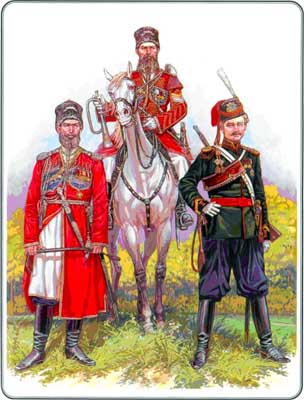
Only officers of the Cavalry and Horse Regiments wore a scarlet cloth tunic, which belonged to a special, so-called. festive, shape. It was the same cut as the white one. The collar, cuffs, gaps in braid, and piping of the uniform of the cavalry guards are light blue, in the Horse Regiment they are dark blue. Galun and buttonholes according to the device.
The vice uniform, which was part of the ordinary uniform, for the lower ranks was single-breasted, black in all regiments, with 9 buttons. The rounded collar and straight cuffs were of uniform color; two buttons were sewn above the cuff at the sleeve seam. Pocket flaps - like on a tunic. When wearing the vice uniform, the lower ranks wore black shoulder straps. The piping along the edge of the collar, cuffs, along the sides and pocket flaps is instrument-colored. The officers in the Horse Regiment have a vice uniform of “royal” color, in the other regiments it is black with two rows of 6 buttons.
Cavalry guards and horse guards in full dress, on special orders - as a rule, when on guard duty in the premises of the imperial palaces, chanted supervest over their tunic. It had the shape of a sleeveless jacket, for the lower ranks it was trimmed around the holes for the head and arms and around the waist with orange braid with a light blue gap for the cavalry guards and dark blue for the horse guards. Below the waist, the supervest ended with cutouts in the form of semicircular petals of light or dark blue, trimmed with orange braid. On the chest and on the back the cavalry guards had a large metal St. Andrew's star, and the horse guards had a golden double-headed eagle. For officers, the braid was replaced with silver or gold braid according to the device.
The cuirass was worn only in equestrian formation and only with a helmet - in ceremonial and ordinary uniform. It was made of brass (yellow copper), trimmed with instrument-colored cord around the head and arm holes, along the sides to the bottom and along the bottom edge. The lining of the scale belts and the belt are made of red leather. Timpani players and trumpeters did not wear cuirasses.
When wearing tunics, the lower ranks wore a white belt made of patent leather, with a plaque on the device, which had an image of the state coat of arms. When wearing a vice uniform, there is a narrow white belt with a tool buckle. The broadsword straps are white. The officers' sword belt was covered with braid according to the device. The lyadunka's sling is braided, with regimental color piping. On the lid of the bottle there is a silver St. Andrew's star.
Only cavalry guards and horse guards were provided with white suede leggings, which were worn with boots made of hard black leather lined with white suede.
Bloomers are blue with instrument-colored piping, shortened for lower ranks, shortened and long for officers (the latter were worn with shortened boots).
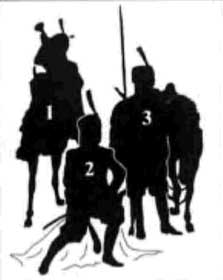
1. Junior constable - trumpeter of the Life Guards Ataman Regiment in full dress uniform.
There is a scarlet plume on the hat. The trumpet, cord and tassels are silver, the fanfare board is blue, with silver St. Andrew's star, braid and fringe.
2. Hundreds of His Majesty’s Life Guards Cossack Regiment rode up in full dress uniform.
The collar and cuffs (since January 23, 1914) had special historical silver embroidery. His Majesty's hundred has a silver monogram “H II”. Black revolver holster, Cossack officer's saber model 1910 with officer's lanyard.
3. Private of the Trans-Baikal fifty of the 4th hundred of the Life Guards of the Consolidated Cossack Regiment in full dress uniform.
Armed with a dragoon rifle. The lower ranks of all Guards Cossack regiments, in full dress uniform, had wooden lances painted in the color of the shoulder straps, a lanyard made of red yuft leather; no weather vanes were assigned to the Cossack regiments.

The lower ranks, in full dress uniform, were armed with a cuirassier broadsword, and in other uniforms, with a saber; with a helmet - a wooden pike (only for the 1st rank), painted in regimental color; with a cap, the pike was steel. The weather vane on the pikes is a cuirassier pattern of regimental colors: cavalry guards - scarlet-white-scarlet, horse guards - yellow-white-dark blue, His Majesty's cuirassiers - light blue-white-yellow, Her Majesty's cuirassiers - light blue-yellow-light -blue.
The cuirassier-style saddle pad (that is, rounded at the front and with right angles at the back), bordered with a wide stripe, along the edges of which was sewn an orange braid (for lower ranks) or braid along the device (for officers). On the front and rear corners there are St. Andrew's stars, for the lower ranks they are cloth, white with a painted center, for officers - metallic silver ones. The cavalry guards have a scarlet saddle pad and a light blue stripe, the Horse Guards have a dark blue with a scarlet stripe, His Majesty's cuirassiers have a yellow and light blue stripe; Her Majesty's cuirassiers have light blue with the same stripe.
Timpani players were entitled to a special white tunic, trimmed along the top of the collar, along the edges and cuffs with gold braid with a scarlet gap. On the chest there are 9 double buttonholes with gold braid with tassels, the gaps are instrument-colored. Musician's shoulder pads were covered with the same braid. The curtains of the timpani were made of cloth with braid and fringe to match the color of the instrument; their colors repeated the colors of the saddle pads. On the blades of the curtains, the St. Andrew's star alternated in Her Majesty's regiment with the monogram "M.F.", in other regiments - with the monogram "N II". Since the timpani players' hands were busy playing the instrument, in addition to the usual reins, they had special belts for controlling the horse, attached to the stirrups.
Life Guards Horse-Grenadier and Dragoon RegimentsDespite the general similarity of uniforms, both regiments had different ceremonial headdresses; The metal device for horse grenadiers is gold, and for dragoons it is silver.
The ceremonial headdress of a horse grenadier was a helmet made of black patent leather with a metal rim along the visor. The scales are always thrown back. Both eyes have scales in the shape of a flaming grenade, under the right one there is a large round officer's or soldier's cockade (like a cuirassier's). In front there is a gold state emblem and on it a silver St. Andrew's star. All ranks of the regiment had a black hairy transverse crest (plume) (except for the trumpeters, for whom it was scarlet). At the back of the crest of the dress uniform, a long scarlet cloth triangular blade (shlyk) was attached, trimmed along the edges and in the middle with orange braid for lower ranks, and gold braid for officers; an orange or gold tassel was sewn onto the end of the blade.

1. Junior non-commissioned officer of Her Majesty's Life Guards Cuirassier Regiment in a uniform out of formation ("cuirassier").
With this uniform, which resembled an ordinary one, the lower ranks wore a helmet with a golden flaming grenade instead of an eagle, a black vice uniform, black collar, shoulder straps and cuffs with regimental color piping (here light blue), the same piping on the pocket flaps. On the collar and cuffs there is a non-commissioned officer's gold (in His Majesty's regiment - silver) braid. Blue trousers with piping in the color of the regiment are tucked into high boots. The belt of the vice uniform is narrow, red yuft, with a tool buckle, the scabbard straps are white.
2. Second lieutenant of the Guards Reserve Cavalry Regiment in full dress uniform.
The dress uniform is similar to the Life Dragoon and Horse Artillery uniform, but with minor differences. The second lieutenant is armed with a saber mod. 1909
3. Private of the squadron of His Majesty's Life Guards Hussar Regiment in wartime marching uniform.
On the shoulder straps (including protective ones) there is scarlet piping and a yellow monogram “H II”. Unlike other regiments, when in marching uniform, the Life Hussars wore dark blue peacetime chakchirs instead of gray-blue ones.
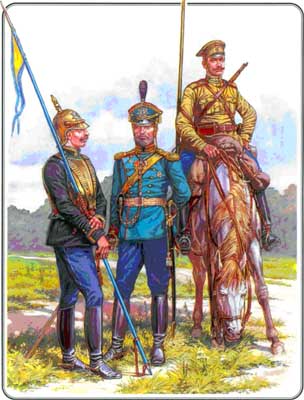
As a ceremonial headdress, dragoons wore a shako, which for the lower ranks was made of black felt. A silver double-headed eagle from the era of Alexander I was attached to the front, and on the sides of the shako there were two strips of black lacquered oilcloth, forming an angle in the shape of the letter “V”. The visor was edged with a metal rim; silver scales. Cockade with applied silver monogram “H II”. In full dress they wore a white plume, while for trumpeters they wore a scarlet one. On the front and back of the shako there are white pendants woven from cord with tassels and a long etiquette cord folded several times. The officer's shako is covered with "royal" color cloth, on the eagle there is a St. Andrew's star: cords of silver filigree (relief) weaving; sultan with silver base.

Lieutenant of the Life Guards Hussar Regiment with a lady. The ladies' coat is trimmed along the cuffs and along the side with cord in the form of a hussar's knot. (From the collection of M.Yu. Blinov.)
The horse grenadier's cap had a uniform-colored crown with scarlet piping, and a scarlet band with uniform-colored piping. For the dragoons it is the other way around: the crown is scarlet with uniform-colored piping, and the pellet is scarlet, edged with uniform cloth.
The uniform of the lower ranks in both regiments was double-breasted (with two rows of 7 buttons each), black with scarlet piping along the side. The collar is slanted, scarlet, with uniform-colored piping. The collar has two buttonholes with orange braid. Scarlet cuffs are triangular in shape with one buttonhole and button. Two buttons are sewn above the cuff at the back seam of the sleeve. The pocket flaps, cut into three toes, had scarlet piping and three buttons. Lapel (fastened bib) - scarlet. The shoulder straps in both regiments are scarlet, the horse grenadiers have dark green piping, and the dragoons have black piping. Officers' uniform made of royal-colored cloth; The buttonholes on the collar and cuffs are gold or silver according to the device.
Bloomers are blue, with scarlet piping. For lower ranks they are shortened, for officers they are shortened and long.
Epaulets for officers are of the cavalry type (made of metal scales), gold or silver with a scarlet lining. The epaulettes of the lower ranks were also metal, scaly, according to the device; among the lower ranks of the Horse-Grenadier Regiment they were supplemented with scarlet fringe.
The Lyadunka was silver with St. Andrew's Star; braided bandage according to the device without piping. The sword belt was also trimmed with galloon. The sash of the lower ranks of both regiments consisted of three stripes (middle black, side scarlet).
The buttonholes of the coat and overcoat in both regiments are scarlet, the edging in the first regiment is dark green, in the second it is black.
A cloth saddle pad with rounded corners. On the rear corners is the monogram “N II”, for lower ranks - printed yellow or white (according to the device), for officers - embroidered in gold or silver.
The saddle pad is uniform-colored with scarlet piping; horse grenadiers have scarlet stripes with crimson piping; dragoons have scarlet stripes without piping.
The pikes of horse grenadiers had scarlet weather vanes with white corners, while the dragoons had weather vanes of alternating scarlet and white stripes of different widths.
Guards Uhlan RegimentsDespite the same uniform, both regiments had some differences in the colors of the parts: the metal device of His Majesty's Lancers was silver, and that of Her Majesty's Lancers was gold.
Uhlan hat with a cap made of black patent leather, with a tetrahedral flared top. Black lacquered visor with metal rim around the device. In full dress uniform, a cloth overlay was put on the cap: yellow for His Majesty's regiment and scarlet for Her Majesty's regiment. The upper and lower edges of the lining were trimmed with white or orange braid for lower ranks, and with silver or gold braid for officers. The edges of the lining were trimmed with cord, white or orange according to the device; for officers of both regiments - with silver cord with black and orange thread. In front is the state emblem on the device and on it is a silver St. Andrew's star. A cockade was attached to the left front side of the tetrahedral top, and for dress uniforms there was a white plume of hair, and for trumpeters - a red one. The base of the sultan was braided with white threads - for privates, white, orange and black - for non-commissioned officers, and silver with an admixture of black and orange threads - for officers. The etiquette cords of the lower ranks are white or orange, according to the device. Officers' etiquettes are silver with St. George's thread in both regiments. The etikket was attached to the hat in the equestrian formation, in the foot formation and outside the formation to the button of the uniform.
Caps with a dark blue crown and piping: yellow for His Majesty's Lancers and scarlet for Her Majesty's regiment: the band was respectively yellow or scarlet with a dark blue edging.
The uniform is the same pattern as that of horse grenadiers and dragoons - dark blue; There is scarlet piping along the side, around the floor, along the back seams of the sleeves and along the seams on the back. The collar is scarlet with dark blue piping and two buttonholes with orange braid. The cuffs are scarlet, with one orange braid buttonhole and button. The lapel is scarlet, the shoulder straps are scarlet with dark blue piping. The officer's uniform has buttonholes according to the device. The epaulettes of officers and lower ranks are made of metal with scales. In the 1st squadron, His Majesty's Lancers have an applied silver monogram “H II” on their shoulder straps and epaulettes.

Staff captain of the Life Guards of the Grodno Hussar Regiment in a winter Hungarian jacket, (from the collection of N.R. Klimov.)
Bloomers are blue with scarlet piping: shortened for lower ranks, shortened and long for officers.
Lyadunka with a silver St. Andrew's star and a sash according to the device. The officer's sword belt is covered with sword belt braid. Belt for the saber of lower ranks made of red yuft. The lower ranks have a sash of three stripes (dark blue in the middle and scarlet along the edges).
The buttonholes of coats and overcoats in both regiments are scarlet with dark blue piping.
The saddle pad is dark blue with rounded corners, scarlet piping and stripes.

A group of volunteers from His Majesty's Uhlan Life Guards Regiment in full dress uniform, 1900s.
Guards Hussar RegimentsThe device in the Life Guards Hussar Regiment is gold, in the Grodno Regiment it is silver. (Further in the text, the colors of the Grodno regiment's uniform are given in brackets).
The ceremonial hat is made of long brown fur with cut scales. The bottom is covered with a scarlet (raspberry) cloth triangular strip that goes down to the right side of the cap. Along the edges and middle of the shlyk, the lower ranks have an orange (white) braid on the device, and the officers have a gold (silver) braid with a zigzag pattern. There is a silver St. Andrew's star in front and a cockade above it. In full dress uniform the plume is made of white hair, while for trumpeters it is scarlet.
The cap - in the Life Guards Hussar Regiment is entirely scarlet with yellow piping, in the Grodno - with a dark green crown and a crimson band, all the piping is white.
The dolman of the lower ranks is scarlet (dark green). The sides, floors and their back section are trimmed with orange (white) cords. On the front of the chest there are double cords in five rows with gold (silver) crutch clasps - oblong buttons. On the front of the floor there is one pocket, lined with cord. Shoulder cords with a button replaced shoulder straps. The collar is dolman-colored, beveled, trimmed with cord along the top and bottom. There was orange braid sewn along the upper edge of the collar, close to the cord, in both shelves. The cuffs are also dolman-colored, with a cord forming a complex knot. There is an orange braid under the cord.
Officers have filigree cords according to the device, instead of braid - galloons according to ranks.

Lower ranks of the Life Guards Dragoon Regiment in full and ordinary uniforms, 1910. (From the collection of A.B. Voronov.)
Mentik is white with a scarlet lining (dark green with crimson). The collar, sides, floors, pockets and cuffs are trimmed with black merlushka; cords and crutches - like on a dolman. The officer's coats have brown beaver fur: the cords are filigree.
The shoulder straps of the lower ranks are scarlet (crimson). On the shoulder straps and shoulder cords of the 1st squadron, the life hussars have a gold applied monogram “H II”.
Ceremonial chakchirs are blue (raspberry). Orange (white) braid is sewn along the side seams. In front there is a complex knot of cord. Officers have galloon along the seam and a knot made of the same galloon. Everyday chakchirs did not have knots.
Lyadunka with a silver St. Andrew's star. The life hussars' baldric with applied gold military fittings (helmet, cuirass and banners) and the monogram "N II" in a wreath against a background of dark blue velvet was trimmed with gold braid with dark blue stripes; among Grodno residents - silver braid with a zigzag. The sword belt is covered with cutlery galloon. The lower ranks have a red yuft belt, a sash made of orange cords with blue interceptions (white with crimson interceptions). The officer's sash in both regiments was silver.
The tashka in the Life Guards Hussar Regiment was scarlet with an embroidered gold ornament; according to tradition, the left branch under the gold monogram “H II” had protruding green leaves. The Grodno regiment has a crimson tashka with a silver serrated braid and the monogram “N II”.
The buttonholes of the coat and overcoat are scarlet (dark green with crimson piping).

Privates of the Life Guards of the Grodno Hussar Regiment, 1900s. (From the collection of A.V. Voronov.)
The saddle pad with rounded front and sharp rear ends for life hussars is blue with gold (officers) or scarlet (lower ranks) cord; the officer's stripe is scarlet with gold braid and cord, for the lower ranks it is yellow with scarlet trim and yellow cords; on the front and rear corners of the officers there is gold embroidered reinforcement, above it is the monogram “H II” (both are small in front, large in back). Grodno residents have a dark green saddle pad with a silver (for lower ranks white) cord and stripe, and on the rear corners there is the monogram “N II”.
His Imperial Majesty's Own ConvoyWith the full dress uniform introduced on September 16, 1895 (uniforms) and January 21, 1898 (hat hats), Convoy officers wore black sheepskin hats with a scarlet cloth top; scarlet Circassian coats, trimmed with silver Caucasian braid with a golden gap; each Circassian coat has 10 gazyrs with silver tips, chains and rosettes (the gazyrs and the triangle under them are covered with dark blue velvet); white beshmets trimmed with Caucasian galloon; dark blue trousers with Caucasian braid; boots without spurs; silver epaulettes with scarlet piping and silver monogram “H II”; gold braided compass braid with gold clasp on the chest and tassel; braided silver belt with a gold gap and a silver buckle: a saber of the Caucasian type on a braided sword belt; a Caucasian dagger on a galloon belt and a revolver in a ceremonial holster (the front surface and bottom of it are of scarlet, and the body is of blue cloth; everything is trimmed with Caucasian galloon) with a double cord of silver thread. The privates had the same uniform, but trimmed with orange braid and with orange shoulder cords of the hussar type (with a silver monogram "H II"). In the ordinary form - dark blue Circassian coats and scarlet beshmets; The officers of all Cossack units had shoulder straps and caps with this uniform; the convoys had caps with a scarlet crown and band (with three white edgings).
Guards Cossack regimentsThe ranks of all guards Cossack units wore uniforms of the same cut, differing only in their colors (see table).
A ceremonial hat made of black merlushka with a cloth semicircular shlyk, orange (silver for officers of cavalry regiments, gold for artillerymen) cords, a white plume, a cockade at the top edge on the left side and a silver St. Andrew's star on the front
The uniform is single-breasted, with a hook-and-eye fastening. The slanted collar and triangular cuffs (without buttons) are of uniform color. The epaulettes of officers and lower ranks are silver (for artillerymen - gold). On the collar and cuffs of the lower ranks there are orange braided buttonholes, and on the officers - on the device.
The lyadunka for all regiments is silver with St. Andrew's star: a sling of silver braid with instrument-colored edging. The Life Guards of the Cossack Regiment have a gold armature on their baldric, under which is the gold monogram “N II”; The Atamans have the same fittings, but silver. The artillerymen wore a gold lyadunka on a gold braided baldric. Officers' sword belts are braided; the lower ranks wear white leather. The sash of the lower ranks is white thread. Bloomers in all patches are blue without piping.
Guards Field Gendarmerie SquadronWith the full dress uniform introduced in 1908... the gendarmes wore the same helmet as the guards cuirassiers, but silver-plated, and at parades in the presence of the Emperor and outside the formation, an eagle was put on it, in other cases - a grenade. The uniform is light blue, with the same collar and cuffs (all with scarlet piping). Officers have silver buttonholes, lower ranks have orange buttonholes; The braid on the collar and cuffs is silver. Blue trousers with scarlet piping. Chakchirs are the color of the uniform, with a scarlet double-row stripe. Officer's epaulettes are of the guards infantry type, silver with scarlet piping, for lower ranks - orange with scarlet piping and two of the same stripes. On the right shoulder the officers have a silver aiguillette, and the lower ranks have an orange one. The lyadunka is silver, with St. Andrew's star, the baldric is silver, without piping. Belt with silver-plated braid, belts with white silk lining. The lower ranks have a white elk belt with a silver buckle. Saber - cavalry officer, mod. 1909 Cap: the crown and pellet are light blue, the crown has the same piping, and the band has scarlet piping. The shoulder straps are scarlet with light blue piping, the buttonholes are light blue. The saddle pad is light blue with scarlet piping, the stripes are the same, the monograms “H II” are gold (yellow). The revolving cord is white, with orange and black threads.
Uniform colors of the Guards Cossack regiments
*Saddle cloth - for all parts with white stripes
Guards Reserve Cavalry RegimentThe dress uniform was introduced in 1908–1909. The officer's shako is of a “royal” color, the braid on the top is according to the ranks, the round cord along the upper and lower edges and the pendants are gold. Sultan - hairy, black. On the front is a silver St. Andrew's star. The lower ranks have a shako made of black felt, along the upper edge there is a scarlet piping and a round orange cord, under it there is an orange braid: instead of a band, an orange cord is sewn along the lower edge; pendants - made of double orange cord; the sultan is black (for trumpeters it is scarlet). The uniform of officers is “royal”, and that of lower ranks is black; on the side there is scarlet edging. The collar and cuffs are scarlet, with gold (orange) buttonholes. Bloomers are blue with scarlet piping. The cap has a uniform-colored crown (scarlet piping) and a scarlet band with piping in the color of the uniform. The buttonholes of the coat and overcoat are scarlet with uniform-colored piping. The lyadunka is silver with St. Andrew's star, the baldric is gold, without piping. Etiquette cord: gold for officers and orange for lower ranks; the latter had a white belt with a gold buckle. All ranks of the regiment were not entitled to a saddle pad. The officers were armed with sabers mod. 1909, the lower ranks of the first rank - pikes with a scarlet and white weather vane of the dragoon type.
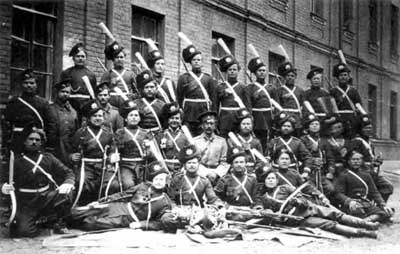
Platoon of the 2nd Orenburg Hundred of the Life Guards of the Consolidated Cossack Regiment, 1910s. (From the collection of I.A. Dzysya.)
Life Guards Horse ArtilleryThe ceremonial uniform of the horse artillery was established in 1907. Officers wore a shako covered with “royal” color cloth, braided top - in accordance with the ranks, cords and pendants - gold, plume - white, band - black with scarlet piping. The lower ranks had a shako made of black felt, an orange cord and scarlet piping ran along the top, a white plume (for trumpeters - scarlet), pendants made of a double orange cord. In front of all ranks there is a black velvet shield with scarlet piping and a gold rim, on it is a silver St. Andrew's star with gold crossed guns and a badge of distinction; scales are golden. The uniform of the officers is “royal”, the lower ranks are black. The collar, cuffs and lapels are black with scarlet piping; Officers have gold embroidery on their collars and cuffs, and lower ranks have orange buttonholes with a black gap. Bloomers are blue with scarlet piping. Epaulets: for officers - cavalry type, gold with scarlet piping, for lower ranks - gold on a scarlet base: applied gold monograms: in the 1st battery - “H II”, in the 2nd - “M” (Grand Duke Mikhail Nikolaevich ). The lyadunka is silver with St. Andrew's star and guns, the belt is gold, without edgings. The sash of the lower ranks is made of three black stripes, along the edges and between them there are scarlet edgings; in front there is a nut of the same colors. The sword belt is made of gold braid, the lining of the belts is black. Checker - officer, mod. 1909 Cap: the crown is uniform color, the band is black, all piping is scarlet. The shoulder straps are scarlet with black piping, with monograms. The buttonholes of the coat and overcoat are black with uniform-colored piping, and along the edge of the collar there is scarlet piping. Uniform-colored saddle pad with scarlet piping, black stripe with scarlet piping, “H II” monograms - gold (yellow).
Horse-sapper teams of the Guards Cavalry DivisionsIn the horse-sapper teams of the Guards Cavalry Divisions and the Separate Guards Cavalry Brigade, a special dress uniform, introduced on February 28, 1914, was assigned only to the lower ranks. Helmet arr. 1874, made of black leather, with a black hairline flowing plume, the state coat of arms with crossed axes and St. Andrew's star. Uniform with lapels, trousers, sash, epaulettes, etiquette cord, cap, coat and overcoat buttonholes, saddle pad like the Guards Horse Artillery. The shoulder straps are scarlet, encrypted by the division number: “D./1|2 |Guards.”
Wartime uniformThe war uniform (travelling) was introduced on the eve of the First World War. For cavalrymen, it included a cap or hat (in winter), a jacket (in summer) or a marching uniform (in winter) for officers and a tunic for lower ranks; bloomers tucked into high boots with spurs; shoulder straps (lower ranks have marching shoulder straps); camping equipment (officers) or belt (lower ranks); brown gloves (officers): a saber on a belt belt and a revolver with a traveling cord (officers) or a saber, a steel pike without a weather vane, a revolver, a dragoon rifle and a cartridge bag (lower ranks). Greenish-gray protective cap, with a protective leather visor, cockade, and chin strap. Officers have a protective marching uniform, with 5 buttons of the same color, 2 breast pockets, a pointed cuff with piping (in the Guards cavalry); jacket - by cut and appearance the same as a marching uniform. The officers had no piping on the pockets of their marching uniform and tunic, but on the cuffs they had the following colors: for His Majesty's horse grenadiers and Cossacks - scarlet, for the dragoons and horse artillery - dark green, for Her Majesty's lancers - dark blue, His Majesty's Lancers are yellow, the Atamans are blue, the Cossacks are white, and the Gendarmes are light blue. Officers and lower ranks of the horse artillery had scarlet piping along the bottom of their collars. Officers could wear both braided (i.e., peacetime) and marching (i.e., protective, with colored gaps) shoulder straps. The lower ranks have a protective tunic with two pockets on the chest, two buttons on the collar and one in the middle of the slit on the chest. On the tunic, the lower ranks had shoulder straps with piping: cavalry guards, horse guards, Cossacks and His Majesty's hussars - scarlet; His Majesty's cuirassiers and lancers - yellow; Her Majesty's cuirassiers and gendarmes - light blue; horse grenadiers, dragoons and horse artillerymen - dark green; Her Majesty's Lancers - dark blue; Grodno hussars are crimson, atamans are blue; half-Cossacks crimson, light blue, scarlet and orange. The shoulder straps of the lower ranks are double-sided, one side is the color of the part, the other is protective. In the 1st squadron, the life hussars on their shoulder straps, including protective ones, had the yellow monogram “H II”. Unlike other regiments, when in marching uniform, the Life Hussars wore dark blue peacetime chakchirs instead of gray-blue trousers. For officers - a brown leather belt (for officers of the Guards Hussar and Cossack regiments and guards gendarmes from red yuft) with two shoulder straps and a galvanized buckle, for lower ranks - black leather with a badge on the device. The saddle for cavalry-type horse equipment is ordinary, that is, a saddle with a full pack and all accessories; headband - with chembur. When equipped with the Caucasian model, the saddle is also ordinary, that is, with a pack and full packing, with a strapped overcoat.
The uniform of the soldiers of the infantry regiments of the New (Foreign) system at the end of the 17th century consisted of a caftan of Polish cut with buttonholes sewn on the chest in six rows, short knee-length pants, stockings and shoes with buckles. The headdress of the soldiers was a cap with a fur trim; the grenadiers had a cap. Weapons and ammunition: a musket, a baguette in a scabbard, a sword belt, a bag for bullets and a gun with charges; the grenadier has a bag with grenades. Until 1700 The soldiers of the “amusing” Preobrazhensky and Semenovsky regiments had a similar uniform.
At the very end of the 17th century. Peter I decided to reorganize the Russian army according to the European model. The basis for the future army was the Preobrazhensky and Semenovsky regiments, which already in August 1700 formed the Tsar’s Guard. 
The clothing of the soldiers (fusiliers) of the Life Guards Regiment of the Preobrazhensky Regiment consisted of a caftan, camisole, pants, stockings, shoes, tie, hat and cap.
A caftan made of dark green cloth, knee-length, had a cloth trim of the same color instead of a collar. The sleeves did not reach the hands, and the ruffles of the shirt were visible from underneath them. The cuffs are split, made of red cloth. Four loops were cut along the upper edge, fastened with copper buttons. There were slits on the back and sides, from the waist to the hem. At the same time, buttonholes were sewn on the sides of the dorsal incision for decoration - three, four, and sometimes the entire length of the floors. In front below the waist there were pockets with five-pointed serrated flaps, which were fastened with four buttons. 12-16 (depending on the soldier’s height) copper, inflated buttons were sewn along the side. The red cord on the left shoulder - a prototype of the shoulder strap - served to secure the belt of the cartridge bag. The lining of the caftan and the edge of the loops were red. The camisole was worn under a caftan and was of the same cut, but shorter and narrower, without cuffs. The pants are knee-length, with copper buttons on the side seams. Until 1720, the camisole, trousers and stockings were dark green or, less commonly, red. The boots were blunt-toed, greased (i.e., lubricated with tar), fastened with a copper buckle covered with a flap on top. On campaigns, privates could wear boots with small bells.
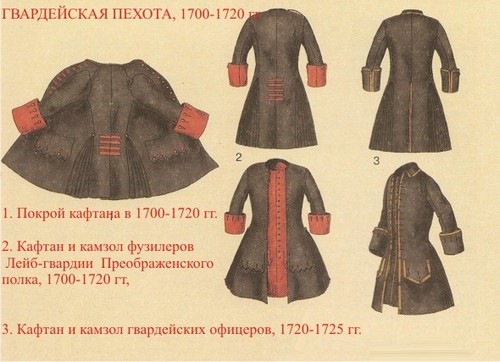 The hat is black, wool, with a round crown. The brim of the hat was trimmed with white braid and turned up, initially on one side, later on three, forming a cocked hat. A camisole button was sewn on the left side. The tie was made of black material and tied with a bow.
The hat is black, wool, with a round crown. The brim of the hat was trimmed with white braid and turned up, initially on one side, later on three, forming a cocked hat. A camisole button was sewn on the left side. The tie was made of black material and tied with a bow.
It was worn in cold, stormy weather. It was made of dark green cloth with a lining of the same color. It was fastened at the neck with a brass hook and loop. The epancha had two collars: the upper one was a narrow turn-down collar and the lower one was wide. The length reached the knees.
The soldiers wore their hair long, shoulder-length, combed in the middle. Beards were shaved, leaving only combed-up mustaches.
The uniform of non-commissioned officers - corporals, ensigns, captains, fouriers and sergeants - differed from the soldiers' uniform by a narrow gold braid sewn along the edge of the brim of the hat and on the cuffs of caftans.
Armament and ammunition of the fusiliers: until 1708, the rank and file were armed with a fusee - a gun with a flintlock 124.5 cm long. Attached to the fusee was a baguette - a flat blade with an iron bow at the handle, inserted directly into the barrel. Since 1708, the Russian army adopted a triangular 55-cm bayonet with a bayonet tube. In the same year, soldiers were given swords in sheaths made of unblackened leather as bladed weapons. The sword belt was made of elk leather and fastened with a copper buckle. A cartridge pouch was worn over the right shoulder on an elk belt. A small bag for fusey flints was sewn under the lid. Initially there were no decorations on the bag. However, soon it began to be decorated with a copper plaque with the monogram of Peter I, and later with a double-headed eagle.
The weapons and ammunition of non-commissioned officers were generally the same as those of soldiers. The sub-ensign was armed only with a sword, the captain-armus carried a leather bag over his left shoulder for spare cartridges. In addition to the sword, the sergeants were armed with a halberd.
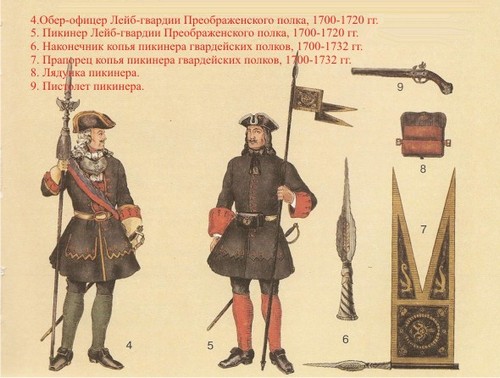
The officers of the Life Guards Preobrazhensky Regiment wore a uniform almost identical to the uniform of the privates. As a rule, when sewing officer's clothing and ammunition, fabrics and leather of higher quality were used than those of privates. In addition, gold braid was sewn along the side, the edges of the cuffs and pocket flaps of the caftan and camisole, along the side seam of the pants and the edge of the hat brim. The hat was decorated with a plume of white and red feathers. The buttons of the uniform were gilded, and the caftan had a dark green lining. The officer's tie was made of white linen. In addition, officers were provided with elk skin gloves. In ceremonial ranks, officers had to wear large wigs with curls.
Chief officers - ensign, second lieutenant, lieutenant, captain-lieutenant and captain - had silver breastplates with a gilded border. The sign featured a crown and St. Andrew's cross made of blue enamel. Staff officers - major, lieutenant colonel and colonel - had gilded badges, without an inscription, a cross - white enamel. All signs were worn on a blue St. Andrew's ribbon. The staff officers' scarves had gold tassels, the majors and lieutenant colonels had a white stripe mixed with silver, and the colonels had a red stripe mixed with gold.
Officers' scarves were worn over the right shoulder and tied in a knot at the left side.
The weapons and ammunition of the officers consisted of a sword with a lanyard and a protazan. The sword was worn on an elk sword belt, edged with gold braid. The chief officers' lanyard was silver, and the staff officers' lanyard was gold. In the ranks, the officers were armed with a protazan, which was a flat spear with an image of a double-headed eagle on the feather and a crescent-shaped base. The feather ended in a round tube and a metal apple. At the place where the pipe was attached to the shaft there was a brush: for chief officers it was silver, for staff officers it was gold. The total length of the hammer with the shaft is 261 cm.
It should be noted that both the officer's protazan and the sergeant's halberd were never used as weapons themselves, being a command signal or a badge of honor.
IN war time the first rank of fusiliers - up to a third of the total number - was transformed into pikemen. The clothing of the pikemen was absolutely the same as that of the fusiliers.
The weapons and ammunition of the pikemen were: a spear with a black shaft (341 cm), a sword and a pistol. The tip of the spear was triangular and often decorated with a gold notch. An ensign was attached to the tip - a flag made of black material, with a golden image of a double-headed eagle and golden dragons. On the front, on the belt, the pikemen wore a cartridge cannon.
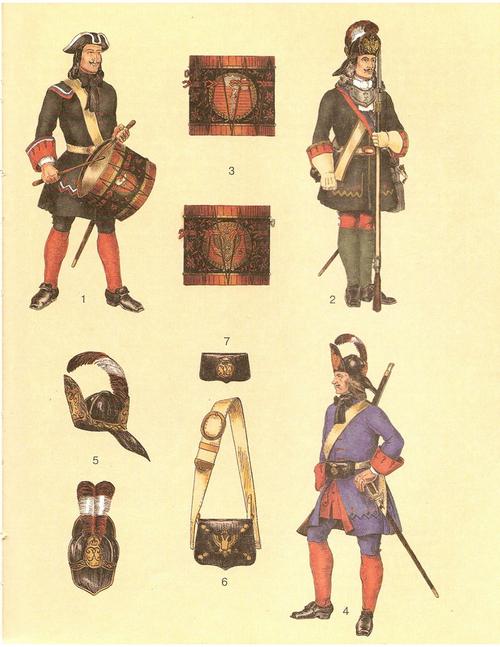
In addition to the listed ranks, a fusilier company was supposed to have two drummers and one oboist. The cut and color of their clothing basically did not differ from the soldiers' clothing, but there were the following features of the musicians' uniform: a narrow woolen braid of three stripes was sewn along the sides of caftans, camisoles, along the edges of cuffs and pocket flaps - white, blue and red. In addition, the drummers had an overlay of dark green cloth trimmed with three-color braid sewn on their right shoulder, under the drum band.
Weapons and ammunition: all musicians were armed with swords. The drum was worn over the right shoulder on an elk sling with an iron hook. The drum was wooden, 41.8 cm high and 44 cm in diameter. The drum body was painted with green paint and painted with patterns. On one side there was a double-headed eagle on a red field, on the other - a hand descending from the clouds with a drawn sword.
In each of the guards regiments, except for the fusilier battalions, there was one grenadier company. The uniform of the Guards grenadiers differed from the fusiliers only in that instead of a triangular hat they wore grenadier caps made of black leather, decorated with an ostrich feather. The shape of this headdress made it possible to throw grenades without touching the wide brim of the cocked hat.
The grenadier's hat consisted of a round leather crown, with a high forehead and back plate. At the back of the crown was attached a copper plaque with the monogram of Peter I, to which was attached an ostrich feather of white and red colors. The forehead was decorated with a copper plaque with an embossed image of a double-headed eagle. The hat of the Guards Grenadier officers was distinguished by gold embroidery in the form of leaves on the forehead and around the crown and a gilded metal device.
The weapons and ammunition of ordinary grenadiers were distinguished by the fact that the fusée had a shoulder strap threaded through two iron rings attached to the gun stock. When throwing grenades, the fusee was worn behind the back, over the left shoulder. The sword belt and sword were of the generally accepted type. On the front of the belt was worn a cartridge bottle with 12 rounds, with a round badge in the form of a flaming grenade, with an embossed Tsar's monogram. Over the left shoulder on an elk sling is a grenadine bag, decorated at the corners of the lid with flaming grenades.
Grenadier chief officers had the same insignia - a sword with a lanyard, badge and scarf - as the fusiliers. The lyadunka was worn not on the belt, but over the right shoulder, and instead of the protazan they were armed with a light fusee with a bayonet and a shoulder strap with gold braid,
A grenadier company was supposed to have two drummers and one flutist.
Until 1720, the cut of clothing, weapons and ammunition of the Preobrazhensky Life Guards and Semenovsky Life Guards regiments were the same. The only difference was the color of the caftans - dark green colors in the Preobrazhensky regiment and light blue (light blue) in the Semenovsky regiment (Fig. 4).
In the first half of 1700, 29 infantry regiments were formed. However, by 1724, the number of regiments had increased to 46.
The clothing of the army (field) infantry regiments was no different in design from that of the guards, but the colors of the cloth from which the caftans were made were extremely variegated. In some cases, soldiers of the same regiment wore uniforms of different colors.
Until 1720, a very common headdress was a cap (Fig. 1-2 on p. 13). It consisted of a cylindrical crown and a band sewn to the crown and cut on the sides so that in cold weather it could be lowered down. A fabric visor, the same color as the band, was sewn to the front of the crown. The color of caftans, camisoles, and trousers often depended on the wishes of the regiment commander and could be: dark and light green, light blue, blue or cornflower blue, red, yellow, white, gray and homespun.
Camisole pants were made not only from cloth, but also from deerskin and goatskin, and sometimes from leggings. The stockings were plain - green, red, white, blue or striped using the specified colors. Ties were made from black or red material. Buttons could be made of cloth, horn, tin or copper. In many field regiments, the color of certain items of clothing depended on the wishes of the regiment commander or was not established at all.
The colors of the uniforms of some army infantry regiments in early XVIII V

The uniforms of field infantry non-commissioned officers differed from soldiers' uniforms by gold braid on the cuffs of their sleeves and, in some regiments, on the brims of their hats ( drawing of a sergeant).
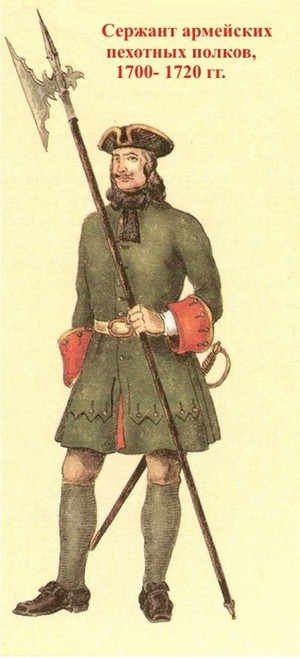
Officers of army infantry regiments in the first quarter of the 18th century did not maintain uniformity in uniforms and, often, the color and cut of their uniforms were strikingly different from the soldiers of their regiment. Like the guards uniform, the caftan, camisole and the edges of hat brims were trimmed with gold braid. At the same time, just as in the guard, officers of army regiments were assigned scarves and badges (officer's drawing).
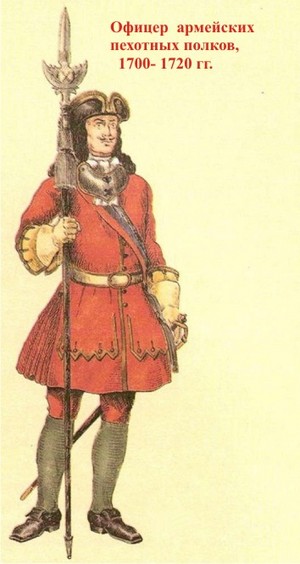
From their formation in 1700, army infantry regiments consisted exclusively of fusilier companies. But during 1704-1705. one grenadier company was formed in the regiments, and by 1711 five special grenadier infantry regiments were created.
Army grenadiers, unlike the guards, wore high, pointed cloth hats with a band and a tassel on the top of the forehead. Officers' grenadier hats were made of velvet, and the tassel was gold or silver.
The ammunition and weapons of the fusiliers and grenadiers of the field regiments generally corresponded to the weapons of the Life Guards, differing only in more modest decoration. For example, there were no decorations on the cartridge pouch, lyadunka and grenade pouch. Moreover, in the first half of the 18th century. a variety of fuze guns made in Russia, purchased in Holland, or acquired as war trophies during the war with Sweden was preserved. The officers' weapons were even more colorful. Swords could have silver or gold hilts; in some cases, protazan tassels were simply made of colored silk. Officer badges could also be of any shape. Uniformity with the guard was maintained only in sword lanyards and officer scarves
The garrison troops, formed by 1711 in the number of 43 regiments from the streltsy, soldier and reiter regiments of the old model, were divided into three categories: the first consisted of garrisons - Moscow, Smolensk, Arkhangelsk, Kazan and Siberian provinces; the second - St. Petersburg, and the third - Azov and Kiev provinces. The uniforms and weapons of the garrison regiments were no different from those of the army.
Simultaneously with the formation of the infantry in 1700, two dragoon regiments were created. Later, by 1711, their number in the army of Peter the Great was increased to thirty-three.
The uniform of ordinary dragoon regiments did not differ significantly from the uniform of field infantry fusiliers; Only in the equestrian ranks were they given boots - blunt-toed greased boots with bells, valves and iron spurs.
The uniform of the non-commissioned officers of the dragoon regiments was no different from that of ordinary dragoons.
 The officers of the dragoon regiments were dressed in the same way as the infantry officers. When riding on horseback, they were required to wear boots with sockets and copper spurs.
The officers of the dragoon regiments were dressed in the same way as the infantry officers. When riding on horseback, they were required to wear boots with sockets and copper spurs.
The armament and ammunition of the dragoons consisted of: a fusee with a shoulder strap, an infantry-style sword or broadsword, distinguished by a long (96 cm), wide and heavy blade, and a pistol. In equestrian formation, the fusee was worn on a pantalier - an elk sling with a copper hook, securing the end of the barrel in bushmat - a leather tube attached to the front right side of the saddle.
The pistol was worn in a leather holster - olstra - on the left side of the saddle.
The officers' armament consisted of an infantry-style sword with a lanyard and two, pistols, located in olstra on both sides of the saddle, covered with cloth or velvet ingots.
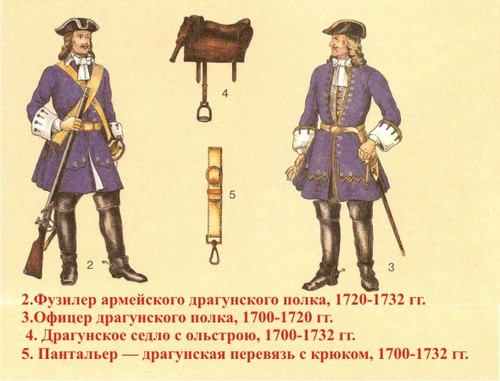
In the period from 1708 to 1711. Three Dragoon Grenadier regiments were created. In them, all ranks wore grenadier hats of the same type as grenadiers in the infantry. A grenadine bag, modeled on the infantry one, was added to their ammunition.
Cavalry Guards 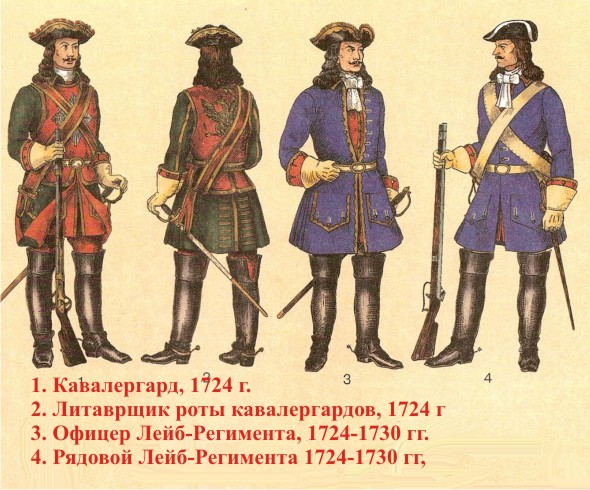
On the occasion of the coronation celebrations of Empress Catherine I in 1724, a mounted company of cavalry guards (“drabants” - i.e. bodyguards) was established from 75 selected chief officers of army regiments. Peter I himself receives the rank of captain of the cavalry guards.
The uniform of the combat ranks was as follows.
A caftan made of green cloth, with a green turn-down collar, red cloth cuffs and gilded buttons. A wide gold braid was sewn along the collar, cuffs, sides, pocket flaps and along the back slit; the camisole loops were trimmed with a narrow gold braid. The camisole and trousers were red, cloth, and also trimmed with gold braid.
A supervest made of red cloth was worn on the caftan, on the chest of which the St. Andrew's Star was embroidered in silver, and on the back - in gold and black silk - a double-headed eagle. The edge of the supervest had gold embroidery. The cavalry guards' hats were trimmed with wide, jagged braid, and a bow of white silk ribbons and a gold button were attached to the left side. Along the edge of the fields there was a plume of white and red feathers. The tie was white, the gloves were made of elk leather, with gold braid along the edge of the bell. Treads - with gilded spurs.
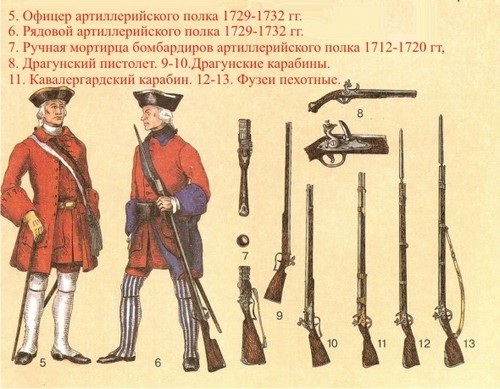 The timpani player's and trumpeter's uniforms were trimmed with gold braid along all seams.
The timpani player's and trumpeter's uniforms were trimmed with gold braid along all seams.
Weapons and ammunition of the cavalry guards: a broadsword with a gilded hilt and a silver neck, a scabbard made of white leather, a lanyard made of gold. The cavalry guard carbine had a gilded device and gold braid on the shoulder strap. The belt, carbine and lyadunochka slings, as well as the lyadunka, were trimmed with red velvet and gold braid along the edges. The buckle of the sword belt was gilded, and the lid of the lyadunka, saddle cloth and ingots were decorated with the golden monogram of Peter I. After the death of the emperor, these monograms were changed to the monogram of Catherine I
Life Regiment
The rank and file of the Life Regiment were assigned the uniform of a dragoon field regiment. However, during the reign of Catherine I, from 1727, all combat ranks of the Life Regiment, while maintaining the blue color of their caftans, received a collar; cuffs and camisole of red cloth. Privates and constables are entitled to gold braid on the collar, cuffs and along the edge of the hat brim (see Fig. 4). The musicians' uniform was trimmed with galloon along all seams.
Headquarters and chief officers have a jagged gold braid on their collar, cuffs, hat, along the side of their caftan and camisole (see Fig. 3).
All other ammunition and weapons of the Life Regiment were no different from those of the Guards.
These minor changes in uniforms were practically the only ones during the reign of Empress Catherine I (1725-1727).
A much larger innovation was the distribution of all regiments into “essential” apartments. As a consequence, in February 1727, the regular army and garrison regiments were renamed according to the provinces in which they were stationed. So, for example, the Butyrsky Infantry Regiment became the 1st Moscow, the Lefortovo - the 2nd Moscow, the Arkhangelsk Dragoon Regiment - the Smolensky, the General Governor's Regiment of the St. Petersburg Garrison - the Poshekhonsky, etc. Only the Life Guards, the Life Regiment retained their previous names and regiments of the Ukrainian land militia.
Artillery Regiment
At the end of 1727 at Russian throne Emperor Peter II ascended. Almost immediately he abandoned the reforms of Catherine I and returned, with rare exceptions, the names of the regiments that existed before February 1727.
Following the example of the Prussian army, Peter II introduced powder, braids, sleeve cuffs and boots with buttons to the troops. For the first time these changes affected the artillery regiment.
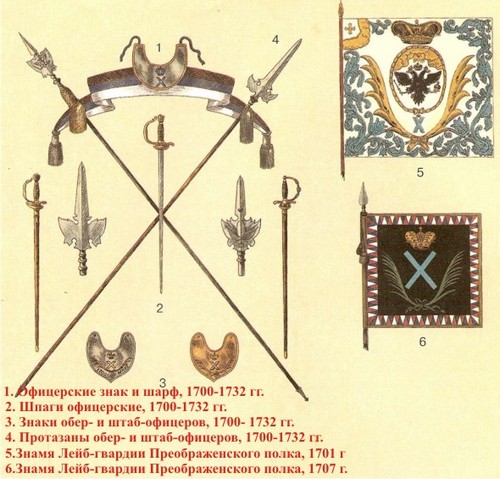
In 1729, the fusiliers of the artillery regiment retained the red color of their caftan, camisole and trousers. The collar, cuffs and lining of the caftan are blue. Instead of stockings - boots made of white linen with blue stripes, tied under the knee with a black belt. The tie is black.
The shape of the hat changed - the brim, trimmed with white wool braid, was raised, the corners were rounded. All combat ranks of the artillery regiment powdered their hair, collecting it in curls at the temples and in a braid at the back that reached almost to the waist. The braid was braided with black leather or ribbon, which was tied with a bow at the level of the collar. In formation, a scarf made of blue material was worn over the right shoulder.
Corporals and sergeants had a narrow gold braid sewn onto their collars, cuffs and hats. Non-commissioned officers were required to wear canes, which in service were attached with a leather lanyard to one of the top buttons of the caftan.
Privates and non-commissioned officers wrapped the hem of their caftan with the lining up and fastened them to each other with small hooks.
The armament and ammunition of the rank and file consisted of a fusée with a bayonet, a sword and a cartridge canister on the front of the belt.
The officers wore a caftan, camisole and trousers made of red cloth. The cuffs on the caftan were made wider than before. Boots and a tie are white, gloves are with cuffs. The hat was the same style as that of privates, but gold braid was sewn along the edge of the brim (see Fig. 5).
In formation, officers wore a scarf with silver tassels over their right shoulders - for chief officers, there were three stripes - white, green and red; for staff officers, instead of white, there was a silver stripe.
The history of the guards uniform in general is a vast topic, which the author wanted to touch upon only in the most general terms, as much as it relates to the main theme of our story. The uniform of the regiments of the Russian Imperial Guard underwent evolution, like any military uniform Russian Empire throughout the history of its existence. From its inception, the “fashion” of guards dress was invariably influenced by the preferences of Russian autocrats, shaped by foreign military costume, if not completely, then in many of its details borrowed from European armies. The beginning of this trend was laid by Emperor Peter 1, who dressed his Guard in foreign uniforms, tailored according to the canons of “German dress”, as a consequence of the Highest Decree on the transition of all subjects from January 4, 1700 to wearing “European clothes”. The first award for officers of the Preobrazhensky and Semenovsky regiments for courage at the Battle of Narva in the form of an image of two crossed palm branches applied to the officers’ “neck badges” was directly borrowed from Swedish symbols, which served as the distinctive sign of the headquarters officers of the army of King Charles XII.
Unknown hood Portrait of Major S.L. Bukhvostova. First quarter of the 18th century
Over time, Peter, who devoted enough time to uniforming the Russian army, introduced elements of French and German uniforms, and five years after the decree on “European clothing,” the entire Russian army was equipped to match the armies of Europe. The guardsmen's wardrobe consisted of cocked hats, epanchas, double-breasted caftans with wide lapels and cuffs, knee-length trousers (in summer time), embroidered or knitted stockings and shoes with buckles. In 1712, the grenadiers of the Preobrazhensky and Semenovsky regiments received new hats ordered for them from British hatters. One of the notable features of the new hats was the plumes, which consisted of three ostrich feathers inserted behind the headdress into a special metal tube. The innovation, brought from the British Isles, remained in the headdress of the Russian guardsman for another 84 long years.
Since 1700, the Guard has not received a strictly regulated uniform; It was only proper for the guards to observe the “regimental” colors. There were no strict restrictions regarding the decoration of the ceremonial uniform, and wealthy Guard officers sometimes competed with each other in the amount of gold embroidery and skillfully embroidered braid, behind which one could barely discern fragments of cloth on which fancy ornaments were applied, and shiny galloon trim designed to emphasize the solemn ceremonial dress .
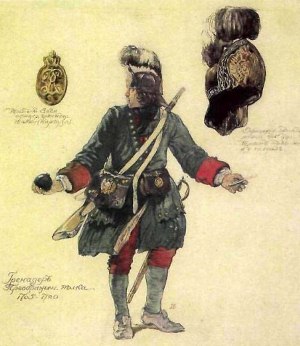
D. N. Kardovsky. Grenadier of the Life Guards Preobrazhensky Regiment 1705-1720 Around 1909
The combat version of the uniform had a more conservative appearance, which included insignia in the form of officer insignia, the color of a lanyard or a scarf. The uniform regulations as such appeared in the Russian Empire only in 1720, defining the guards uniform in all its details and preserving it throughout the 18th century in the same form: dark green uniforms trimmed with braid, collar, cuffs and pocket flaps gold However, even during the reign of Peter, an example of one of the most remarkable guards uniforms was the cavalry guard uniform, established by the emperor in 1724. Consisting of a dark green uniform, richly embroidered with gold, with red cuffs, red trousers, embroidered, like the camisole, with gold braid, and a red velvet supervest with a silver eight-pointed St. Andrew's star, it was a splendor designed to emphasize the solemnity of the coronation ceremony of Catherine I. Imperial monograms topped with a crown were applied to the lyadunki, “ingots” and scoops of the cavalry guards. Since then, the presence of cavalry guards has become an integral part of coronation and other celebrations of the empire.
The splendor of the Guard's uniforms, which set off court celebrations, received significant development during the reign of Anna Ioannovna, during which in 1738-1739 the Guards regiments began to be distinguished by shoulder straps worn on the left shoulder, red, green or blue. During this reign, staff officers received an additional row of braid along the side of the camisole. Anna Ioannovna laid the foundation for the formation of the Horse Guards, renaming the Life Regiment as such in her decree of January 4, 1731.
The newly born Guards Cavalry Regiment was lavishly outfitted “according to cuirassier regulations”, using high quality material and the most expensive finishing elements.
“The Horse Guards and Cavalry Guards were a single knightly order of the empire, embodying the brilliant and formidable beauty of Imperial Russia. The ceremonial uniforms of Horse Guards officers during the reign of Anna Ioannovna bore a touch of the opulent splendor of the era: gold braid sewn in the form of loops along the side of the camisole was combined with gold-embroidered cuffs of the uniform sleeves, pocket flaps, and its back slit. Since 1730, the officers' scarves of the guards acquired the traditional “cuirassier” colors - they strikingly combined yellow and black.
During the reign of Elizabeth Petrovna, guards officer badges acquired their final roundness and horseshoe shape. Since 1745, the silver braid on officers' sword belts has been replaced by gold, and the silver lids of guards' chests began to be covered with gold. In the days of the “Merry Empress Elizabeth”, in 1746, guards chief officers said goodbye forever to plumes on their hats, which had become the privilege of guards staff officers and army generals. Particularly worth mentioning is the splendor of the uniforms of the ranks of the Life Campaign, the grenadiers who elevated Elizabeth Petrovna to the throne. Elevated to the nobility, equal in rank to army lieutenants, these last grenadiers became the owners of a uniform that was striking in its splendor. Their grenadier caps were covered with red cloth, the caps had gilded metal parts, and the headdresses themselves were crowned with lush plumes of white and red ostrich feathers. The clothing of the Life Campans consisted of green caftans with red lining, as well as red trousers and camisoles embroidered with gold braid. Their neck insignia depicted the monogram of the Empress surrounded by military fittings, and the embossed dates of her accession to the throne gleamed dimly.

F. Moskvitin. Oath of the Preobrazhensky Regiment to Elizabeth
For special occasions, life-campans were dressed in cavalry guard scarlet supervests with embroidered double-headed eagles and double gold braid and fringe along the edge. At the same time, the officers of the Horse Guards slightly reduced the decoration of their uniforms, which now looked much more modest compared to those that were still vividly remembered by everyone who had seen them in all their splendor during the previous reign.
With the death of Her Majesty, the new Sovereign, who was attracted by everything connected with Holstein, dear to his heart, worked hard to make changes to the guards uniform, remaking it in the Prussian manner. Thus, Russian grenadiers received hats, the shape of which was directly borrowed from the Prussian Life Guards.
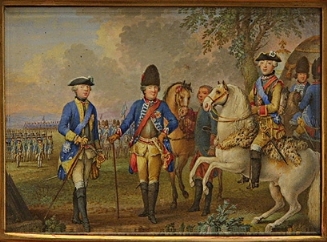
Peter III. Miniature on a snuff box.
From the beginning of 1762, the Horse Guards were dressed in elk cloth tunics, with a red device, lined with bright gold braid. Copper sashes and tashkas with gold galloon lining and red cloth covers were added to the Horse Guards uniform, which is why the appearance of the Horse Guards uniform not only did not lose, but even acquired new, no less attractive features.
Having ascended the throne, Empress Catherine II waged war against Prussian influence on army and guards fashion, in particular. In relation to the guards uniform, this was reflected in the desire new Empress to a certain conservatism in preserving the old forms of uniform, with the possibility of distinguishing regiments by small and minor details of the uniform and accessories, which even extended to the heterogeneity of decoration of the lids of the caps and grenadier bags. Some changes in the color of uniforms appeared after 1775, when red trousers were replaced by white cloth trousers, which were worn with white linen shoes in all forms of clothing. In the changing forms of the military uniform, excessive panache slipped, and features appeared, formed largely by the French influence of fashion on the guards uniform. The perfection of a headdress or uniform was often achieved at the expense of its practical benefits. Since 1775, when the Guards cavalry was augmented by the Life Hussar squadron and two Cossack escort teams, this event introduced additional insignia and uniform options.
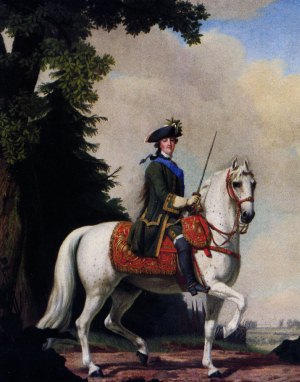
Eriksen Vigilius. Catherine II in a guards uniform. no earlier than the second half of 1762
The reign of Paul 1 introduced some dull monotony into the former multicolored guard uniform, which was condemned after the fact by many of the Emperor’s subjects. The grenadiers received new Prussian-style headdresses; The Guard's uniforms remained dark green with a bluish tint and red lining. Non-commissioned officers received a cane as a rank accessory, and in formation they marched with halberds painted in the “regimental” color. Guard officers received epontons in addition to the sword, which made the appearance of the officers more impressive during parade parades. The officer's uniform became the same cut as that for the lower ranks. From the very beginning of 1796, the introduction of a new officer's double-breasted uniform with a red lining for lower ranks and green for officers began. Red ties were introduced for privates and officers. From December 16, 1798, in connection with the Sovereign’s acceptance of the title of Grand Master of the Order of St. John of Jerusalem, the Maltese white cross on a red field became an integral attribute on the headdress of the grenadiers. After 8 months, the grenadier foreheads were decorated with a large double-headed eagle with a shield in the center, on which was a white cross on a red field. Above the eagle was the Sovereign’s monogram, and a ribbon on which the word “Grace” appeared in honor of Anna Lopukhina, the Sovereign’s favorite, whose name was translated in this way from the Hebrew language.
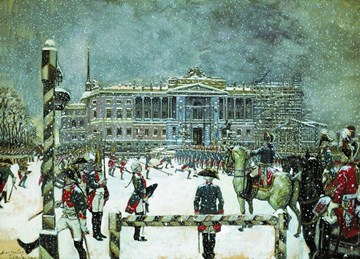
Benois A.N. Parade under Paul I
Semyonovsky and Izmailovsky officers received new sewn buttonholes, additionally located along the side, on pocket flaps and on the bodice. The buttonhole pattern remained unchanged until last days these regiments in the 20th century. The sewing established for the Preobrazhensky uniform also remained unchanged until the end of the existence of the Imperial Guard.
And during the reign of Paul, the Life Guards Cavalry Regiment did not go unnoticed. The Horse Guards were given army cuirassier uniforms, red vice uniforms with blue cuffs and a collar for officers. The sashes differed in color by squadron: orange, turquoise, scarlet, purple, etc. In 1797, in preparation for the coronation celebrations, by order of Pavel Petrovich, who was preparing to become Sovereign, the Cavalry Corps was again formed.
By the highest decree, the cavalry guards were granted cuirassier-type uniforms with a collar and a red device. For celebrations, one of which was supposed to be the upcoming coronation, a black supervest with red trim was worn over the cavalry guard jacket; in particular, for the upcoming celebrations, the cavalry guards were going to add to the existing dress a cuirass with an image of a black double-headed eagle on the chest and back, as well as such exotic uniform attributes as bracers and legguards. The headdress was a silver helmet with a plume of white ostrich feathers. In addition, cavalry guards were entitled to a fringed scarf worn over the shoulder. However, when the Cavalry Corps was disbanded six months later, part of its armor passed on as ceremonial uniforms to the Life Guards Horse Regiment. A year and a half after the coronation of the Sovereign, the cavalry guards were destined to become the honorary escort of His Majesty, who assumed the burden of the Grand Master of the Order of St. John of Jerusalem, and therefore the uniform of these guards again underwent some qualitative changes. For ceremonial occasions, the supervestites of the honor guard are now crimson in color with a Maltese cross in the center and silver braid. At the corners of such a supervest were golden lilies with a golden crown. Now at celebrations, cavalry guards wore black lacquered helmets with an applied gilded double-headed eagle. The helmets were decorated with plumes, as always red for the lower ranks and white for the officers. One of the remarkable ceremonies in which the cavalry guards participated during the reign of Paul 1 as the Guard Master of the Order of Malta was the ritual of lighting bonfires on the eve of Midsummer, which was performed with special triumph by the Knights of Malta.
From January 11, 1801, the Cavalry Regiment was equalized with the rest guards regiments, losing their previous advantage. They entered the general composition of the troops, holding first place in the ranks of cavalry regiments and retaining the advantage granted to the regiment by Peter 1 - to have one of their officers guard the throne during the sacred rite of crowning the Russian monarchs. For off-duty wear, corps ranks were given a red uniform with black trim and white lining. This uniform had white buttons; To top it all off, it came with a gold aiguillette and an epaulette on the left shoulder. The officer's uniform also had a velvet cutlery, as well as a wide gold braid. The change in guards fashion also reached other regiments: the life hussars were given green ments with sable edges. Life hussar officers were required to wear a leopard skin with a red lining and trimmed with silver galloon.
This new, essentially decorative, attribute of the life hussar dress was worn diagonally over the right shoulder. The hind and front paws of the leopard were fastened on the chest with a silver medallion with an applied gold imperial monogram. Instead of the previous fur hats, the hussar's head was now decorated with a shako with yellow cords.
After the regicide on the night of March 11-12, 1801, Tsar Alexander 1, who ascended the throne, made a lot of efforts to further decorate the guards uniform, spending many hours developing new models of uniforms, delving into the most insignificant details and designing new samples. The hairstyles of the Guard were also not ignored by the royals. On April 9, 1801, the Highest commanded all military ranks to cut off their curls and shorten their braids to 4 inches. The cut of the uniform underwent further changes, which was finally fixed by new regulations - “uniform states” in 1802. The Guard, and the army in general, received newfangled tails-cut uniforms, with missing lapels, and a new high standing collar to replace the established tradition of the caftan, which came to the army from the 18th century. It seemed that the Alexander era was striving with all its might to make up for the innovations in army fashion lost in the previous, Pavlovian, times, in particular from the first dandies of the European armies, the British, who held the brand.
Already at the end of 1802, new guard states were approved, according to which the uniforms became shorter, the French cut of cuffs replaced the Prussian one, the braided buttonholes of the guards infantry were abolished, and the cut of the soldier's overcoat changed. The officers also received as uniforms an overcoat for the cold season of exactly the same cut as the soldier's, but with a wide and round cape. Helmets were preserved for some time, but from October 19, 1804, cylindrical cloth hats, or shakos, with attached visors, decorated with wide plumes, up to half a meter high, inserted into a special pocket lined with leather, were introduced for everyday wear. A burdock of the color assigned to a given battalion was also attached under the plume.
On September 17, 1807, epaulettes were introduced, which until 1809 were worn only on the left shoulder, leaving space on the right for aiguillettes, and a new cut of general's uniforms, which the Russian military mocked, saying that they were more like a valet's livery than a uniform military leader.
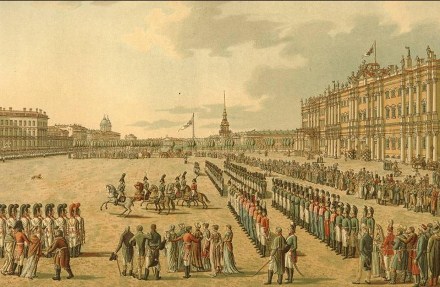
Patersen B. Parade in the presence of Alexander I. 1810s.
In 1808, the shako of the Russian lower rank acquired character traits French infantry shako from two years ago. In the same year, guards officers received new insignia, different from those that were in their uniforms during the previous reign. These signs were smaller in size and had a more rounded shape compared to the previous ones.
The successes of Russian weapons in Patriotic War 1812 made the image of the Russian soldier very popular in the allied armies, which even tried to borrow some elements of uniform from the Russian Imperial Army, in particular even adopting the form of a shako, which was introduced in the Prussian army, and then in some other European armies. And although the French ARMY was defeated in the last war, even five years after it, “innovations” such as the infantry shako, which resembled its French original, continued in the Russian army and guard.
1813 was the time when, considerably supplemented by new regiments (Life Cuirassiers, Life Grenadiers and Pavlovsk), the Russian Imperial Guard was divided, like the French, into “Old” and “Young”, but their guards status was finally consolidated two years later, in February 1815. The officers of the Young Guard were awarded guards-style insignia and St. Andrew's stars for scoops and ingots. Initially, the “Young Guard” had an advantage over the army in one rank, while the “Old” - in as many as two. The lower ranks of the Young Guard wore white buttonholes, not yellow. The Life Guards Pavlovsky Regiment retained old grenadier caps of the 1802 model as a reward for the Friedland battle with the French troops. Five years after the victorious end of the Patriotic War, the turn came to modifications of the uniform of the “Old Guards” - the ranks of the Preobrazhensky, Semenovsky, Izmailovsky and Jaeger regiments. In 1818, officers of the Guards infantry and cavalry had their neck badges replaced, which were similar in design to the French ones. These signs were in the shape of a crescent with the Russian state emblem located in the center - a double-headed eagle sitting on military fittings. The chief officers of the Preobrazhensky and Semenovsky regiments received the privilege of retaining the former inscription “1700/No. 19” on the sides of the eagle.
At the beginning of the reign of Sovereign Alexander Pavlovich, the uniforms of the main cavalry regiments of the Guard - the Cavalry Guard and the Horse - remained unchanged. Only the headdresses and the cut of the uniform collars were changed, but then changes in uniforms followed quite often. First, in the summer of 1801, cuirasses were abolished; a year later, cavalry guards received tunics with a high red collar, red cuff and lapels. In 1803, all combat ranks of the Cavalry and Horse Regiments were ordered, as a ceremonial headdress, to wear leather helmets with a crest, with a dense hair plume, white for officers and black for privates. All helmets had St. Andrew's Star on the copper forehead. At the end of 1803, the cavalry guards received the same tunics as the Horse Guards, with the only difference being that the tunic buttons were white and not yellow, as in the friendly regiment. In 1807, cavalry guards were ordered to wear a silver epaulette on their left shoulder, in contrast to horse guards who wore a gold one. In 1808, the plumes on the cavalry and horse guards cuirasses gave way to trimmed black horsehair crests, except for the musicians of the regiments, who had red crests. In 1812, both regiments received black lacquered cuirasses, fastened on the shoulders with belts with brass figured scales, and at the waist with red leather belts.

“Prayer service on the eve of the Battle of Borodino”
Color lithograph from a drawing by N. Samokish.
Military Historical Museum of Artillery, Engineering Troops and Signal Corps on the website http://www.museum.ru/1812/Painting/Borodino/index.html
The New Year of 1813 added a new regiment to the family of heavy guards cavalry, called the Life Guards Cuirassiers. Five years later, the Life Guards Podolsk Cuirassier Regiment was formed in Warsaw. The spring of 1814 brought innovations to the guards uniform: double-breasted tunics of all ranks and officer vice uniforms replaced single-breasted ones with 9 buttons, which existed in this form until the end of the reign of Emperor Nicholas 1.
Shortly before the end of Alexander's reign, the Tsar's eyes were turned to determining regimental differences by color of horses. This significant event took place in 1823, when, for example, Cavalry Regiment It was ordered by the Highest to have bay horses, the Cavalry - black, and the Life Guards Cuirassier - red. The selection of horses for chiefs and staff officers in cavalry regiments was supervised by an officer specially appointed to this position, the head of the stable, who carefully ensured that the horses in the regimental stable corresponded to the color established for the regiment. This custom survived well into the twentieth century.
August 1825 last year reign of Alexander 1, made changes to the height of the plumes on the shakos of the guards infantry, which were replaced by round yellow woolen plumes for soldiers and silver-colored plumes for officers.
The reign of his younger brother, Nikolai Pavlovich, which followed the disappearance of the Emperor in December 1825, was not so “turbulent” for the guards uniform. Firstly, the main changes had already been made in previous years, and secondly, there was no practical need for frequent changes in style and cut, as well as color and other properties of the guards uniform. Changes took place mainly in accordance with the aesthetic views of the military uniform of the new Sovereign. It was during this era that the image of the Russian military uniform changed significantly towards the “French” samples of the bygone era of Napoleon Bonaparte. The Emperor thought for a long time about the changes in the guards uniform, which he saw as necessary, and personally created watercolor sketches inspired by his youthful admiration for the bearskin hats of the grenadiers of Bonaparte’s “Old Guard” and the cuirassier helmets with a round plume of the cavalrymen of Marshal Saint-Cyr. Already in 1826, the infantry received dark green trousers with piping along the seams, replacing the previous winter trousers with leggings. A year later, a number of guards regiments received epaulettes with a scaly neck, straight for soldiers and curved for officers, and five-pointed gilded stars for silver epaulettes and silver ones for gold ones. After two years, changes finally affected the uniform buttons, which now received a relief image of the state emblem of the Russian Empire. The cut of the guards infantry uniforms remained unchanged throughout the reign of Nikolai Pavlovich. The Guards Infantry received another modification of the shako in 1828, which differed from the outdated original in its height and a cord label of a different shape around the upper edge. The new shako had two lashes with tassels. The design of the shako coat of arms also underwent minor changes.
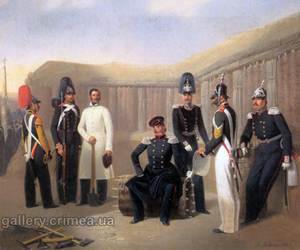
Gebens Adolf Ivanovich
Life Guards Engineer Battalion. 1853
At the end of the reign of Nicholas 1, for officers and generals of the Guard, in addition to the ceremonial overcoat with a cape, a traveling overcoat was also introduced. In its cut it resembled a soldier's uniform, sewn only from very thick cloth. As a distinctive feature of the rank, guards fashion designers attached galloon shoulder straps to the overcoat on a cloth basis. The rank worn by the owner of the overcoat was determined by the number of gaps between the stripes of braid, and the color of the side edging of the shoulder strap indicated its regimental affiliation. The general's shoulder straps were completely covered with wide braid with a zigzag pattern.
It should be noted that five years before changes were made to the metal and decorative details of the uniform of the Guards cavalrymen for internal palace service, the ranks of the Cavalry Guard and Horse Regiments received red supervests. The supervests were sewn from cloth of medium thickness; on the chest and back, the cavalry guards were supposed to have eight-pointed stars with the monogram “A” located in the center, and the horse guards were supposed to have double-headed eagles.
The new reign of Sovereign Alexander II was marked by a truly revolutionary rejection of tunics and tailcoat-type uniforms. They were replaced in March 1855 by the introduction of double-breasted long-length semi-caftans, with collars cut at a so-called obtuse angle, and lapels that evolved into a fastened plastron, worn with certain forms of clothing. In 1858, the cut of the soldier's overcoat changed, receiving a turn-down collar and pockets in the floors, which remained single-breasted. At the end of May 1857, the state emblem of the empire changed, which was reflected in a change in the design on the guards' headdresses. The eagle looked a little different now.
The accession to the throne of Emperor Alexander I was marked by a change in uniform Russian army. The new uniform combined fashion trends and traditions of Catherine's reign. The soldiers dressed in tails-cut uniforms with high collars; all ranks' boots were replaced with boots. Chasseurs (light infantry) received brimmed hats reminiscent of civilian top hats. A characteristic detail of the new uniform of the heavy infantry soldiers was a leather helmet with a high horsehair plume and a colored shlyk at the back, similar to those worn in the Russian army with the so-called “Potemkin uniform” in 1786-1796. However, life showed that outwardly beautiful helmets were not practical, and in 1804 they were replaced with hats, which became the prototype of future shakos. It was in “shako” hats that the Russian Guard took part in the campaigns of 1805-1807.
The grenadiers of the guards regiments differed among themselves in the color of the collars and blades of their hats: in the Preobrazhensky regiment the color was red, in the Semenovsky regiment it was blue (cornflower blue), in the Izmailovsky regiment it was a green collar and a white blade of the cap. Non-commissioned officers were distinguished from private officers by a white plume on the helmet with a black top, a collar trimmed with braid along the front and bottom edges; an additional insignia for non-commissioned officers was a cane, left over from Pavlov's time. The non-commissioned officers were armed with a soldier-style halberd and cleaver. The musicians' uniforms were embroidered with a guards basson; the senior drummer, or “drum chief,” wore the insignia of a non-commissioned officer and always a cane. Officers stood out from the lower ranks with large double-cornered hats (it was no coincidence that in the Battle of Austerlitz the command was heard among the French riflemen: “Aim for the big hats!”); the collars of the uniforms were decorated with gold embroidery of a special pattern for each regiment; There was an aiguette on the right shoulder. The officer's weapons were an esponton and a sword.
The huntsmen, intended to operate in loose formation, were armed with rifles (rifled guns) and wore green uniforms with black belts.
The ranks of the Guards Foot Artillery received the uniform of the Guards Infantry, and the Guards Horse Artillerymen received a uniform of the dragoon type, but with a black collar and cuffs with special Guards embroidery. An additional difference between the ranks in the horse artillery was the hair plumes of the helmets: white with a black ending for officers, black with a white ending and a longitudinal orange stripe for non-commissioned officers, completely black for privates, red for musicians, red with a white ending and an orange longitudinal stripe stripe - at the headquarters of the trumpeters.
The military uniform gradually transformed, following the trends of fashion (the cut of the uniform and equipment changed, shoulder straps appeared), but the traditions were preserved. So, for example, in 1832 L.-Gv. The Horse Grenadier Regiment received helmets similar to the Guards helmets of 1802. 70 years later, during the reign of Nicholas II, the wearing of helmets was prescribed to dragoons and horse artillery, and when developing the uniform of the presidential regiment of the modern Russian army, helmets were one of the proposed options for headdresses.
All engravings used are taken from the album of A.O. Orlovsky "Costumes des Gardes Russes en 1802" ("Form of the Russian Guard in 1802")
Life Guards Preobrazhensky Regiment
The oldest regiment of the regular Russian army, formed from the “amusing” troops of Peter the Great formed in 1683. This army of Peter's childhood was initially based in the village of Preobrazhenskoye, from which the regiment received its name.
The chief of the regiment was always listed as the monarch of the Russian Empire, in 1801-1825. - Emperor Alexander the First.
Guards ranks in the table of ranks had an advantage of 2 steps compared to army officers.
In 1801-1803 the regiment was commanded by Lieutenant General Tatishchev, Nikolai Alekseevich; in 1803-1805 adjutant general, lieutenant general Count Tolstoy, Pyotr Alexandrovich; in 1805-1810 colonel (and from December 1807 - major general) Mikhail Timofeevich Kozlovsky 1st.
In 1801-1811 the regiment consisted of 4 grenadier battalions, consisting of four companies each. According to the staff approved in December 1802, the regiment consisted of 13 staff officers (regiment chief, 4 battalion chiefs and 8 colonels), 74 chief officers (4 captains, 12 staff captains, 18 lieutenants, 20 second lieutenants and 20 warrant officers), 64 senior non-commissioned officers and 96 junior non-commissioned officers. The grenadier company consisted, in addition to the command staff, of 141 grenadiers, 3 drummers and 2 flute players. In total, the regiment was supposed to have 3003 people, together with non-combatants (priests, doctors, barbers, orderlies, artisans, etc.).
In total, the Preobrazhensky Regiment had 22 musicians assigned to the regimental headquarters (4 horn players, flautist, bassoonist, clarinetist, trumpeter and 2 drummers), 1 regimental and 3 battalion drummers. With 3 drummers and 2 flute players assigned to each of the 16 companies, the regiment numbered 102 musicians.
The salary of the regimental drummer was 97 rubles per year, the rest of the regimental and battalion musicians - 57 rubles per year. Company musicians received 18 rubles. 45 kopecks.
The 1st and 3rd battalions of the regiment took part in the war of the Third Coalition against France and participated on November 20 (December 2), 1805 in the Battle of Austerlitz. In the campaign of 1807, the regiment took part in its entirety in the battles of Gutstadt, Altenkirchen and Friedland.
Sources:
1. Pogodin M. Origin of the Preobrazhensky Regiment and the Guard with it. "Russian Bulletin" 1875 No. 2.
3. Staff of the Life Guards Preobrazhensky Regiment dated 12/29/1802.
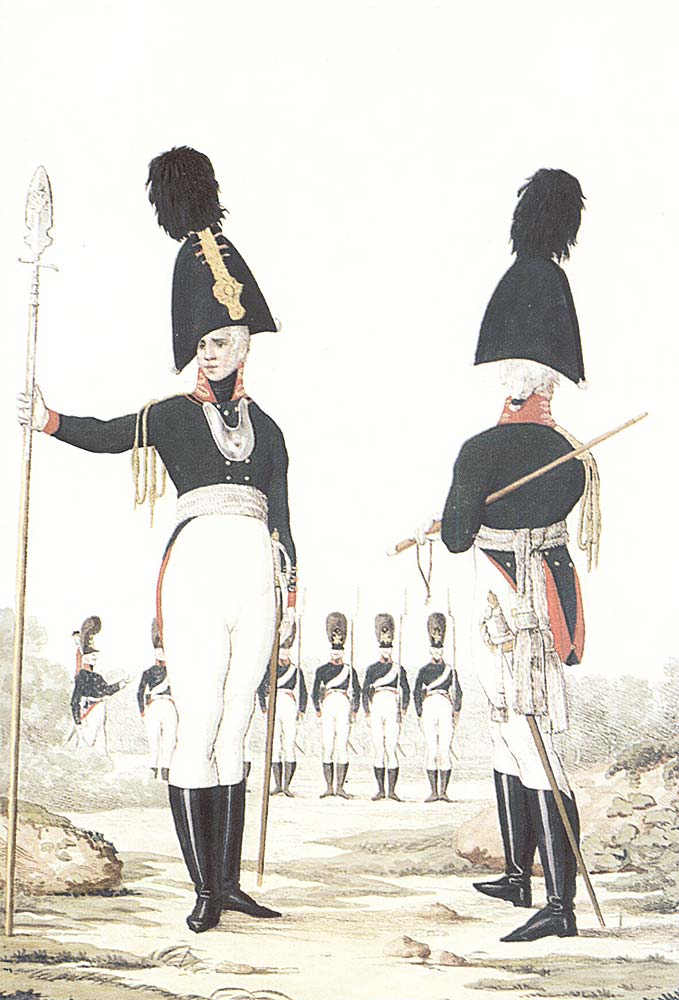


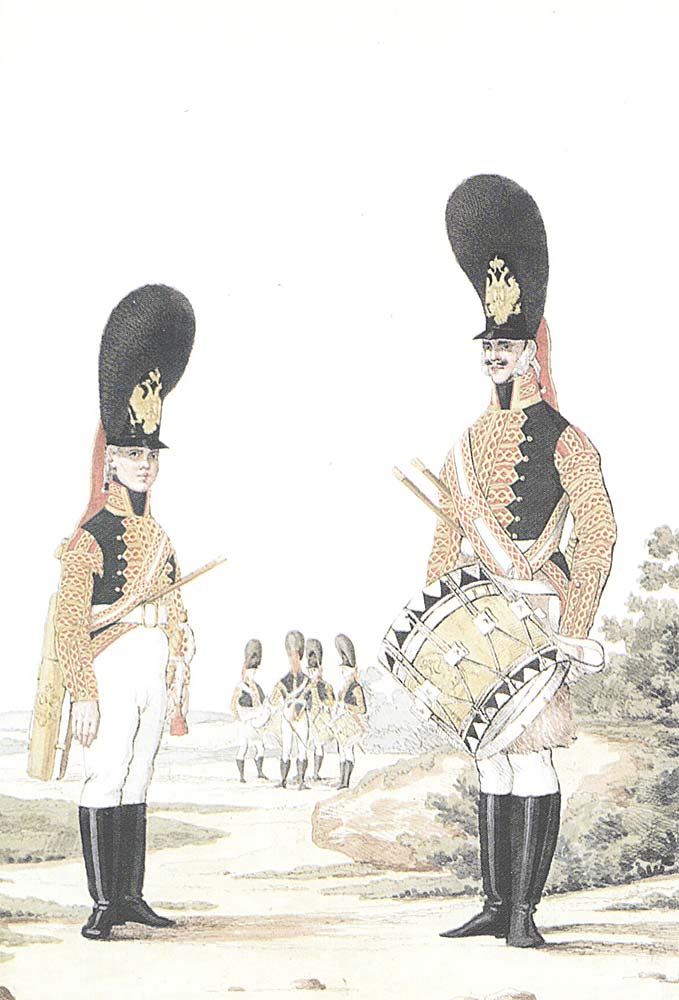

Life Guards Semenovsky Regiment
The Semenovsky regiment was formed in 1691 in the village of Semenovsky from the expanded “amusing” Preobrazhensky soldiers and, thus, became the second regular regiment of the Russian army.
The chiefs of the regiment were traditionally the royals of the Russian Empire. The exception is the period of the reign of Paul the First, when the chief of the regiment was his son Alexander Pavlovich, the future Alexander the First. This explains the privileged position that the regiment occupied during the reign of Alexander. The Emperor always singled it out from the rest and considered it his favorite regiment. This certain spoiling of the Semyonovites by the royal attention to some extent predetermined the “Semyonovsky history”, which will be mentioned below.
When formed, the regiment received blue caftans, and retained the blue instrument color until the end of its existence.
Regiment commander in 1799-1807. was Major General Leonty Ivanovich Depreradovich.
During the War of 1805 with Napoleon, the 1st and 3rd battalions of the regiment took part in a foreign campaign and distinguished themselves in the battle of Austerlitz on November 20 (December 2, new style), losing 3 chief officers and 86 soldiers killed and 217 wounded. In the campaign of 1807, the regiment took part in the battle of Heilberg and the battle of Friedland.
At the beginning of April 1820, Colonel Grigory Efimovich Schwartz, Arakcheev’s protégé, was appointed commander of the regiment. His excessive pedantry, severity and rudeness towards subordinate soldiers and officers (among whom were the future Decembrists Muravyov-Apostol S.I., Bestuzhev-Ryumin M.P., Krasnokutsky S.G.) led to the fact that on October 16, 1820 year, His Majesty’s company refused to carry out the order of the regimental commander and go on guard, for which, under the escort of two companies of the Pavlovsky grenadiers, they were sent to Peter and Paul Fortress. The remaining companies stood up for their comrades, refusing to obey even the highest authorities, and demanded the release of the soldiers, or the entire regiment be placed under arrest. Under the escort of the Cossacks, the disarmed regiment in its entirety was placed in the fortress.
On November 2, 1820, the highest decree was issued on the dismantling of the regiment and the transfer of soldiers and officers to army units (with, however, maintaining guards seniority) without the right of resignation and presentation of awards. The Semenovsky regiment, however, did not cease to exist, retained its privileges and in a short time was recruited from the ranks of the grenadier regiments.
Schwartz was put on trial and even sentenced to death penalty for a harsh and unfair attitude towards his subordinates, but was pardoned and dismissed. After this, he twice returned to military service, and twice, in 1838 and 1850, he was dismissed from service “for abuse of power.”
This incident had far-reaching consequences and was one of the reasons for the beginning of the reactionary policy of Alexander the First (and after him, Nicholas the First).
Sources:
1. Kartsov P. P. History of the Life Guards Semenovsky Regiment: 1683-1854: in 2 volumes. St. Petersburg, 1852,1854.
2. Lapin V.V. Semyonov's story. L., 1991.
3. Shenk V.K. Imperial Guard. St. Petersburg, 1910.

Life Guards Izmailovsky Regiment
The Life Guards Izmailovsky Regiment was formed by decree of September 22, 1730 from the Ukrainian Land Militia. When appointing regiment officers, preference was given to residents of the Baltic provinces.
From 1800 to 1855 the chief of the regiment was Grand Duke Nikolai Pavlovich, later Nicholas the First.
Commanded the regiment in 1799-1808. Lieutenant General Pyotr Fedorovich Malyutin.
By decree of December 29, 1802, the staff of the regiment was approved: 3 grenadier battalions of 3 companies each.
The regiment was dressed in a dark green double-breasted uniform with short tails, with a high dark green collar. The cuffs are also dark green. There are three gold buttonholes on the cuffs and two gold buttonholes on the collar. The blade of the cap is white. The plaques of the 1st battalion, like the backs of their caps, were gilded; the remaining battalions had copper plaques and instrument-colored backs (white). Non-commissioned officers and musicians on the left side of the helmet, behind the plume, wore a white plume with an admixture of black and yellow feathers on top. In 1804, helmets were replaced by shakos. Gray overcoats. On the left shoulder there is one shoulder strap, under which the backpack strap was pushed. The officers wore tall hats with a short black plume and a large gold buttonhole with a star. A gold aiguillette is fastened to the right shoulder. The uniform had long tails. In addition, for formation, officers retained espontons (abolished in 1805), and non-commissioned officers retained halberds (4 non-commissioned officers in each company had rifle guns instead of halberds).
The regiment took part in the campaigns of the anti-French coalition of 1805-1807. On November 20 (December 2), 1805, he took part in the Battle of Austerlitz, losing 20 lower ranks killed and 6 officers wounded. During the campaign of 1807 he fought in action near Gutstadt, during the battle of Heilberg on May 29 he was in reserve; On June 2 he fought in the Battle of Frinland, losing 57 lower ranks killed, 22 officers and about 400 soldiers wounded.
Sources:
1. Brief history of the Life Guards Izmailovsky Regiment: St. Petersburg, 1830.
2. Shenk V.K. Imperial Guard. St. Petersburg, 1910.

Life Guards Jaeger Battalion
The Life Guards Jaeger Battalion was formed on November 9, 1796 "from the Jaeger teams consisting of the Semenovsky and Izmailovsky Life Guards regiments and the Jaeger company of Lieutenant Colonel Rachinsky." Initially it consisted of 3 companies, in 1802 the 4th company was added. On May 10, 1806, the Jaeger Regiment was reorganized into the Life Guards from two battalions of four companies, and on September 16, 180 it received a third battalion, also from 4 companies.
According to the staff of 1802, the battalion included 1 general, 2 staff officers, 15 chief officers, 450 combatant lower ranks and 101 non-combatant lower ranks.
Chief of the regiment in 1806-1812. was General Prince P.I. Bagration. Commanded the regiment in 1806-1809. Colonel Count Emmanuel Frantsevich de Saint-Prix.
In 1802, lower ranks received round hats trimmed with orange lace on top, and non-commissioned officers with gold braid. The tassels on the hats were orange with green centers. An army chasseur uniform, but with split cuffs without flaps, which, like the piping, were orange. There were badges on the collar and cuffs. IN winter time It was ordered to issue green pants and to have white ones in the summer. Officers are allowed to wear leggings while on tour. In 1804, officers were given hats with a buttonhole made of narrow gold braid with a high green plume, and lower ranks were given cloth hats.
During the war with Napoleon 1805-1807. The battalion took part in the Battle of Austerlitz (11/20/1805), on 05/24/1807 it distinguished itself in the battle near the town of Lomitten, where it took a fortified position from the battle, and on 06/2/1807 it fought at Friedland.
Sources:
1. History of the Life Guards Jaeger Regiment for a hundred years. 1796-1896. St. Petersburg, 1896
2. Shenk V.K. Imperial Guard. St. Petersburg, 1910.
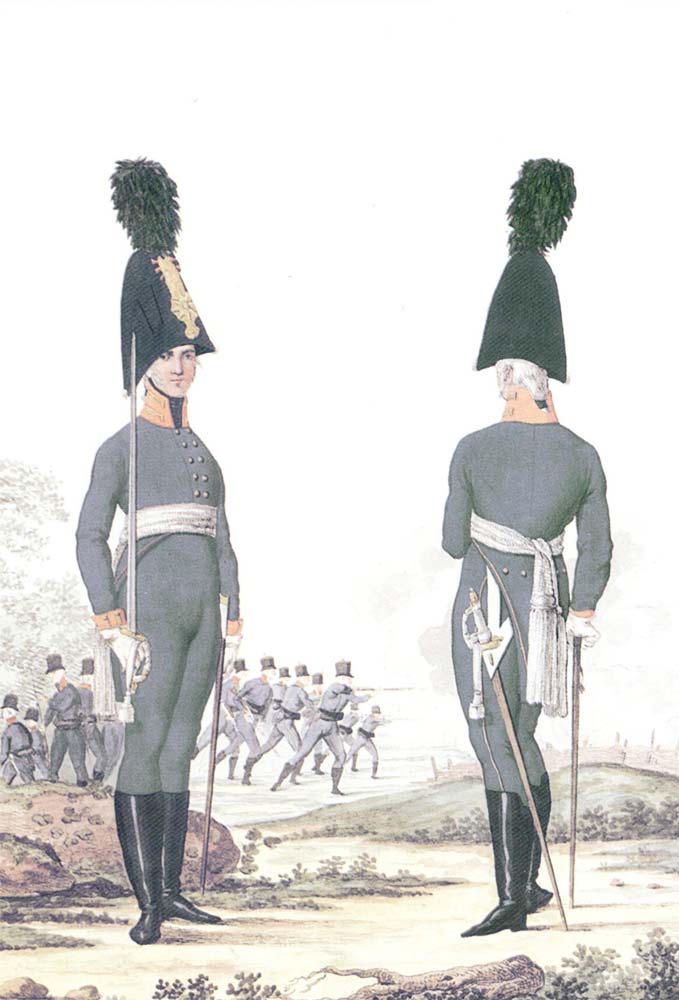

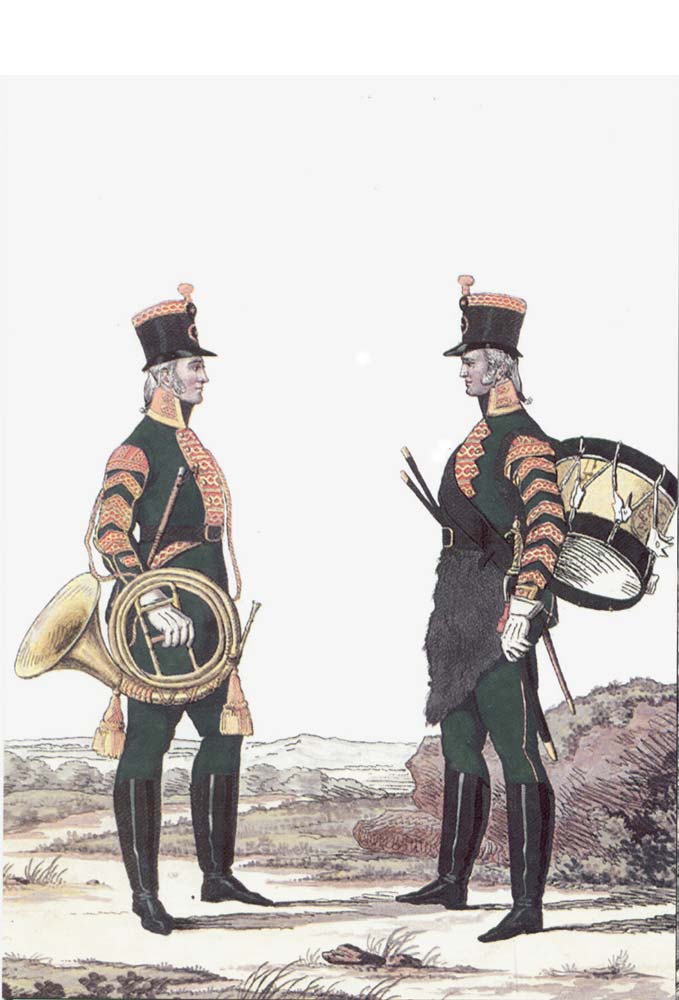
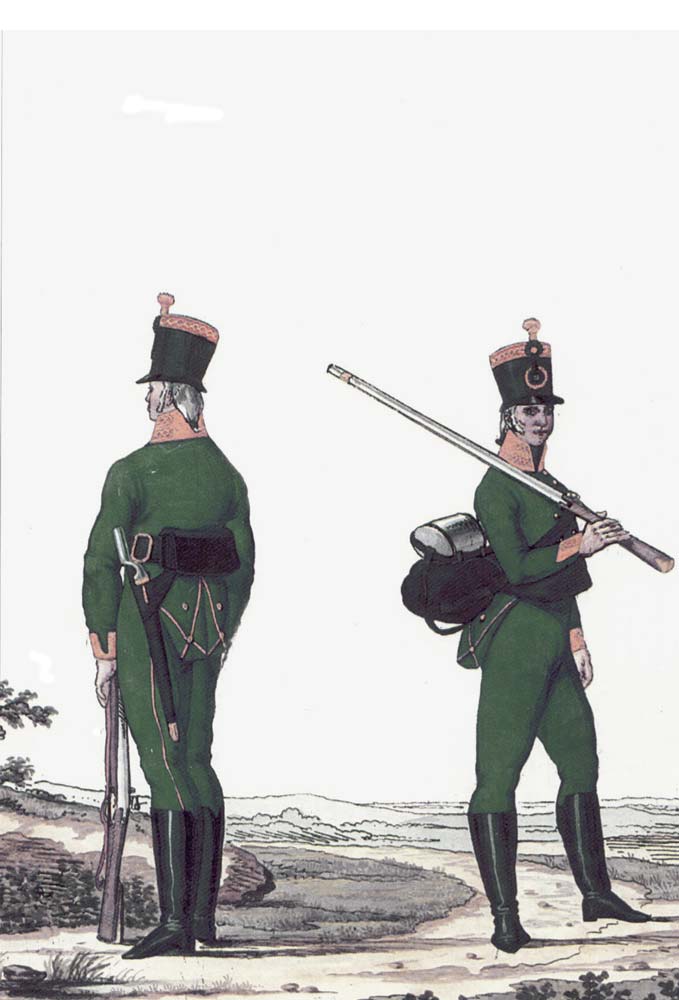
Life Guards Artillery Battalion
The Life Guards Artillery Battalion was formed on November 9, 1796 from the bombardment company of the Preobrazhensky Regiment, a team of gunners from the Semenovsky and Izmailovsky regiments and the artillery of the Gatchina troops.
Initially it consisted of 3 infantry and 1 cavalry companies and 3 teams: pioneer, pontoon and furshtat. Each foot company had 14 musicians. In 1803, 1 more foot company was added, and the newly approved staff consisted of 2 battery, 2 light and 1 horse company. The battery company consisted of 4 1/2 pound unicorns, 4 12-pounder guns of medium proportion, 2 12-pounder guns of smaller proportion and 1 3-pounder unicorn. Each light and horse company included five 12-pounder unicorns and five 6-pounder guns. There are a total of 52 guns in the battalion.
Each battery gun was moved by 6 horses, and each light gun by 4 horses. There were 3 charging boxes for a battery gun, 2 for a light gun and 1 for a 3-pound unicorn. 120 combat charges for each gun.
The battery gun had 14 servants, a light gun had 10, and a horse gun had 12 men.
On March 25, 1805, the cavalry company was expelled and assigned to be separate under the name of the Life Guards Horse Artillery.
Companies of the battalion took part in the campaigns of 1805-1807.
Sources:
1. Pototsky P. History of the Guards Artillery of St. Petersburg, 1896.
2. Shenk V.K. Imperial Guard. St. Petersburg, 1910.
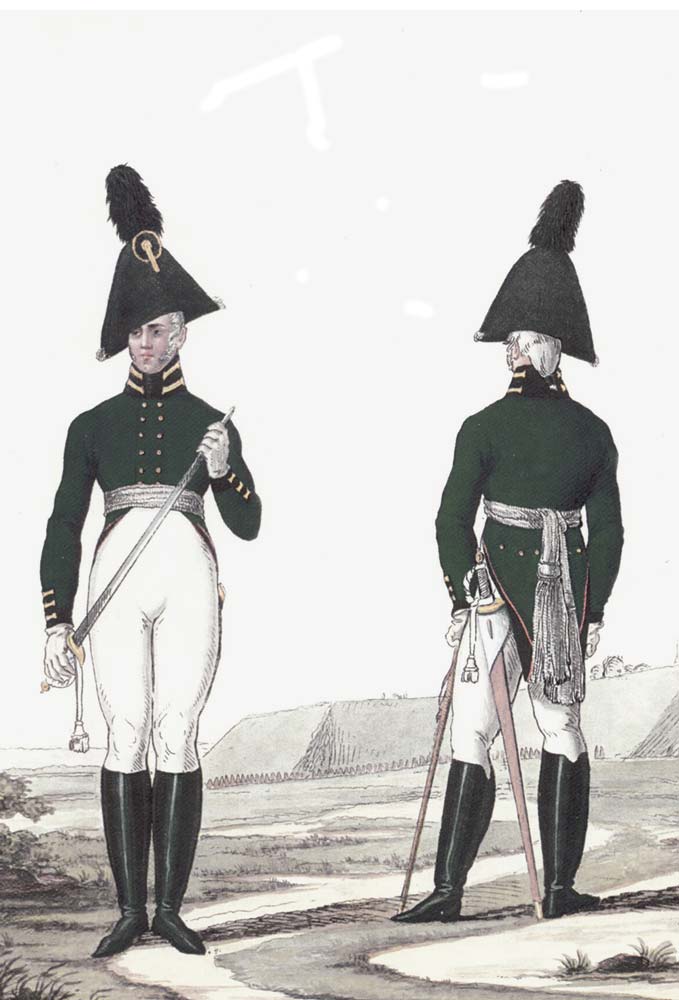


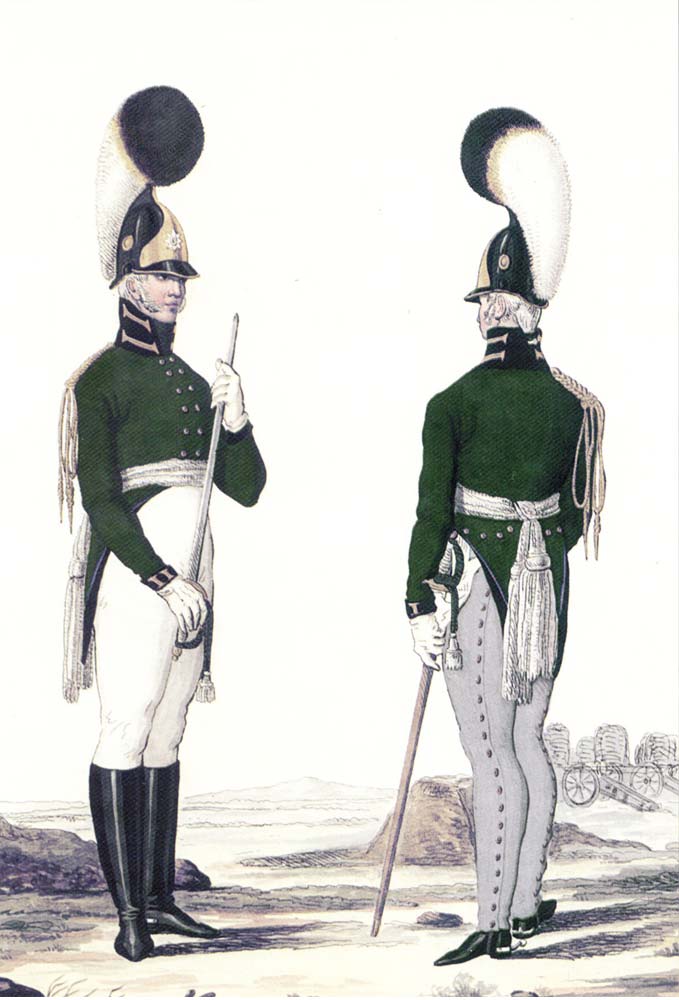

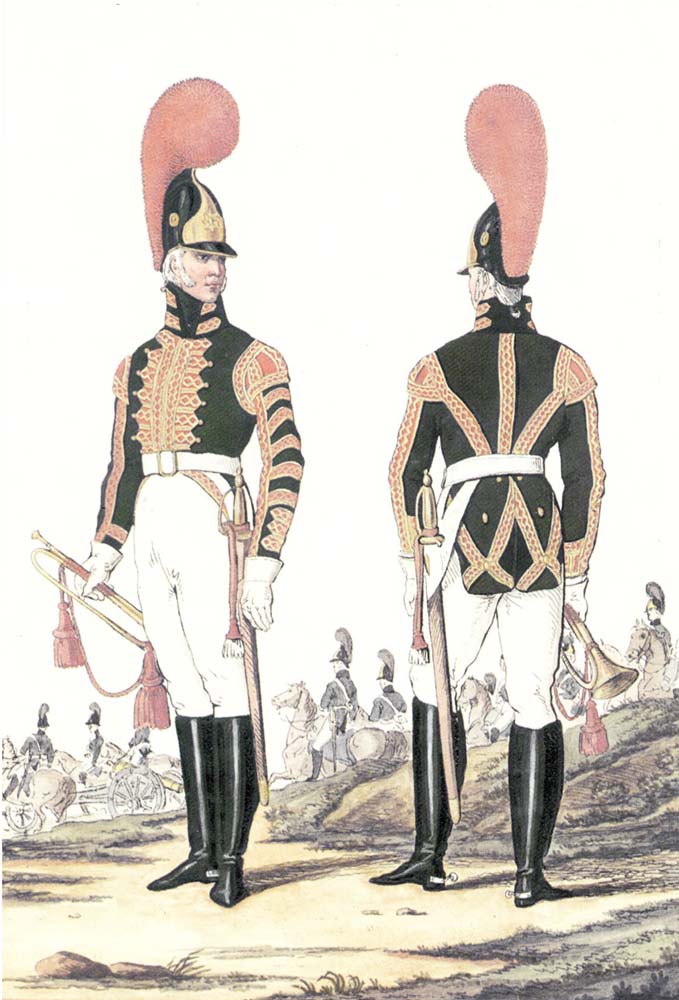
Based on materials from the site: //adjudant.ru/table/rus_guard_1802_1805.asp
Ask a Question
Show all reviews 0Read also
Military uniforms in Russia, as in other countries, arose earlier than all others. The main requirements that they had to satisfy were functional convenience, uniformity across branches and types of troops, and a clear difference from the armies of other countries. The attitude towards the military uniform in Russia has always been very interested and even loving. The uniform served as a reminder of military valor, honor and a high sense of military camaraderie. It was believed that the military uniform was the most elegant and attractive
The gorget is a crescent-shaped metal plate measuring approximately 20x12cm, suspended horizontally by the ends on the officer's chest near the throat. Designed to determine the rank of an officer. More often in the literature it is referred to as an officer's badge, a neck badge, an officer's breast badge. However, the correct name for this element of military clothing is gorget. In some publications, in particular in A. Kuznetsov’s book Awards, the gorget is mistakenly considered a collective award badge. However
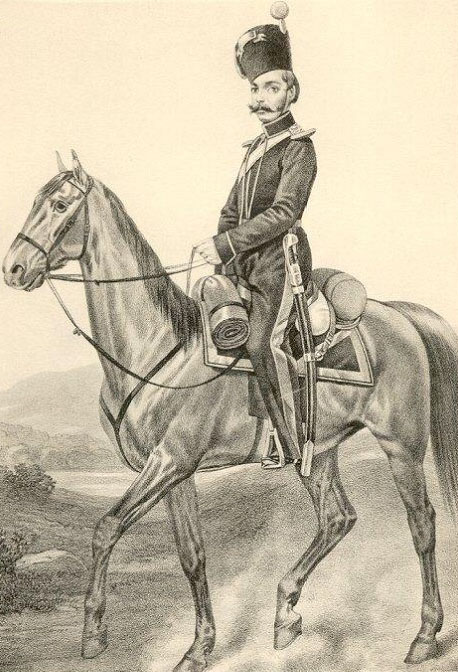 Until April 6, 1834, they were called companies. 1827 January 1st day - Forged stars were installed on officer epaulettes to distinguish ranks, as was introduced in the regular troops at that time 23. July 1827, 10 days - In the Don Horse Artillery companies, round pompoms were installed for the lower ranks made of red wool; officers had silver designs 1121 and 1122 24. 1829 August 7 days - Epaulets on officer uniforms are installed with a scaly field,
Until April 6, 1834, they were called companies. 1827 January 1st day - Forged stars were installed on officer epaulettes to distinguish ranks, as was introduced in the regular troops at that time 23. July 1827, 10 days - In the Don Horse Artillery companies, round pompoms were installed for the lower ranks made of red wool; officers had silver designs 1121 and 1122 24. 1829 August 7 days - Epaulets on officer uniforms are installed with a scaly field,
A document regarding the clothing of the army, submitted by Field Marshal Prince Grigory Potemkin-Tavrichesky to the Highest Name in 1782. In former times in Europe, everyone who could, had to go to war and, in the manner of the then battle, fight with white weapons, everyone, As his wealth grew, he burdened himself with iron armor, protection that extended even to horses, then, undertaking long campaigns and forming into squadrons, they began to lighten themselves; full armor was replaced by half
Espanton protazan, halberd Espanton, protazan partazan, halberd are actually ancient weapons of the polearm type. The espanton and protazan are piercing weapons, and the halberd is a piercing-cutting weapon. By the end of the 17th century, with the development of firearms, they were all hopelessly outdated. It is difficult to say what Peter I was guided by when introducing these antiquities into the arsenal of non-commissioned officers and infantry officers of the newly created Russian Army. Most likely modeled on Western armies. They didn't play as weapons
The clothing of military personnel is established by decrees, orders, rules or special regulations. Wearing a naval uniform is mandatory for military personnel of the state armed forces and other formations where military service is provided. In the Russian armed forces there are a number of accessories that were in the naval uniform of the times of the Russian Empire. These include shoulder straps, boots, long overcoats with buttonholes and insignia
Continuity and innovation in modern military heraldry The first official military heraldic sign was established on January 27, 1997 by Presidential Decree Russian Federation the emblem of the Armed Forces of the Russian Federation in the form of a golden double-headed eagle with outstretched wings holding a sword in its paws, as the most common symbol of the armed defense of the Fatherland, and a wreath a symbol of the special importance, significance and honor of military labor. This emblem was established to indicate ownership
Officers of the Cossack troops, who are attached to the Office of the Military Ministry, front and festive uniform. May 7, 1869. Life Guards Cossack Regiment marching uniform. September 30, 1867. Generals serving in the army Cossack units wear full dress uniform. March 18, 1855 Adjutant General, listed in Cossack units in full dress uniform. March 18, 1855 Aide-de-camp, listed in Cossack units in full dress uniform. March 18, 1855
They do not emit a warlike roar, they do not sparkle with a polished surface, they are not decorated with embossed coats of arms and plumes, and quite often they are generally hidden under jackets. However, today, without this armor, unsightly in appearance, it is simply unthinkable to send soldiers into battle or ensure the safety of VIPs. Body armor is clothing that prevents bullets from penetrating the body and, therefore, protects a person from shots. It is made of materials that dissipate bullet energy and destroy
 THE GOVERNOR EMPEROR, on the 22nd day of February and the 27th day of October of this year, deigned to give the highest command to 1. Generals, Headquarters and Chief Officers and the lower ranks of all Cossack troops, except the Caucasian, and except for the Guards Cossack units, as well as civil officials consisting in the service in the Cossack troops and in regional boards and departments in the service of the Kuban and Terek regions, named in articles 1-8 of the attached list, Appendix 1, have a uniform according to the attached
THE GOVERNOR EMPEROR, on the 22nd day of February and the 27th day of October of this year, deigned to give the highest command to 1. Generals, Headquarters and Chief Officers and the lower ranks of all Cossack troops, except the Caucasian, and except for the Guards Cossack units, as well as civil officials consisting in the service in the Cossack troops and in regional boards and departments in the service of the Kuban and Terek regions, named in articles 1-8 of the attached list, Appendix 1, have a uniform according to the attached
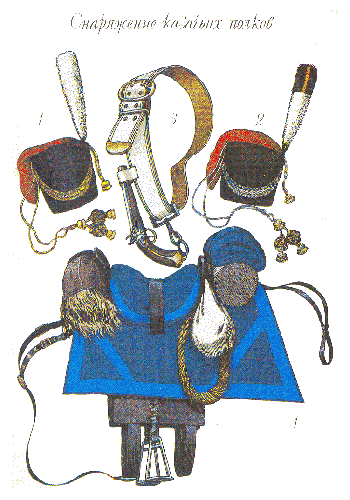 The army is the armed organization of the state. Consequently, the main difference between the army and other government organizations is that it is armed, that is, to perform its functions it has a complex of different types of weapons and means that ensure their use. The Russian army in 1812 was armed with bladed weapons and firearms, as well as defensive weapons. To edged weapons, the combat use of which is not related to the use explosives for the period under review -
The army is the armed organization of the state. Consequently, the main difference between the army and other government organizations is that it is armed, that is, to perform its functions it has a complex of different types of weapons and means that ensure their use. The Russian army in 1812 was armed with bladed weapons and firearms, as well as defensive weapons. To edged weapons, the combat use of which is not related to the use explosives for the period under review -
 Almost all European countries were drawn into the wars of conquest that the French Emperor Napoleon Bonaparte continuously waged at the beginning of the last century. In a historically short period of 1801-1812, he managed to subordinate almost the entire Western Europe, but this was not enough for him. The Emperor of France laid claim to world domination, and the main obstacle on his path to the pinnacle of world glory was Russia. In five years I will be the master of the world,” he declared in an ambitious outburst, remains
Almost all European countries were drawn into the wars of conquest that the French Emperor Napoleon Bonaparte continuously waged at the beginning of the last century. In a historically short period of 1801-1812, he managed to subordinate almost the entire Western Europe, but this was not enough for him. The Emperor of France laid claim to world domination, and the main obstacle on his path to the pinnacle of world glory was Russia. In five years I will be the master of the world,” he declared in an ambitious outburst, remains
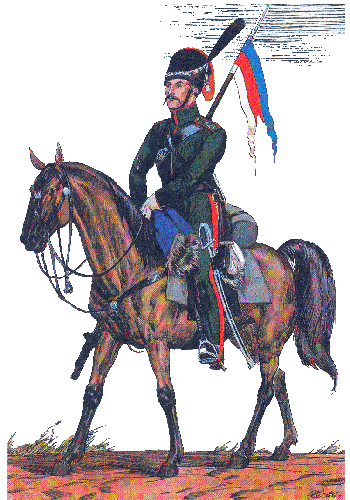 107 Cossack regiments and 2.5 Cossack horse artillery companies took part in the Patriotic War of 1812. They constituted irregular forces, that is, part of the armed forces that did not have a permanent organization and differed from regular military formations in recruitment, service, training, and uniforms. The Cossacks were a special military class, which included the population of certain territories of Russia, which made up the corresponding Cossack army of the Don, Ural, Orenburg, and Ukrainian
107 Cossack regiments and 2.5 Cossack horse artillery companies took part in the Patriotic War of 1812. They constituted irregular forces, that is, part of the armed forces that did not have a permanent organization and differed from regular military formations in recruitment, service, training, and uniforms. The Cossacks were a special military class, which included the population of certain territories of Russia, which made up the corresponding Cossack army of the Don, Ural, Orenburg, and Ukrainian
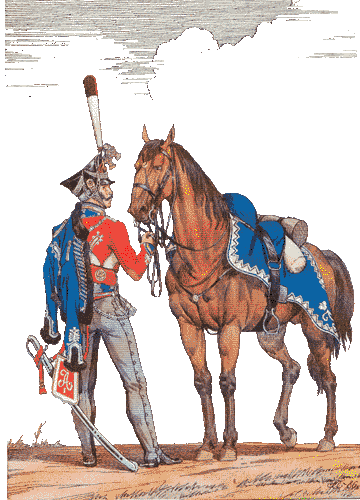 The Russian army, which holds the honor of victory over the Napoleonic hordes in the Patriotic War of 1812, consisted of several types of armed forces and branches of the military. The types of armed forces included the ground forces and the navy. The ground forces included several branches of the army: infantry, cavalry, artillery and pioneers, or engineers now sappers. The invading troops of Napoleon on the western borders of Russia were opposed by 3 Russian armies of the 1st Western under the command of General
The Russian army, which holds the honor of victory over the Napoleonic hordes in the Patriotic War of 1812, consisted of several types of armed forces and branches of the military. The types of armed forces included the ground forces and the navy. The ground forces included several branches of the army: infantry, cavalry, artillery and pioneers, or engineers now sappers. The invading troops of Napoleon on the western borders of Russia were opposed by 3 Russian armies of the 1st Western under the command of General
During the reign of Alexander III there were no wars or major battles. All solutions for foreign policy were accepted personally by the Sovereign. The position of state chancellor was even abolished. In foreign policy Alexander III took a course towards rapprochement with France, and in building the army, much attention was paid to recreating Russia's naval power. The Emperor understood that the lack of a strong fleet had deprived Russia of a significant part of its great power weight. During his reign it was established
 The science of ancient Russian weapons has a long tradition; it arose from the discovery in 1808 of a helmet and chain mail, possibly belonging to Prince Yaroslav Vsevolodovich, at the site of the famous Battle of Lipitsa in 1216. Historians and specialists in the study ancient weapons last century, A.V. Viskovatov, E.E. Lenz, P.I. Savvaitov, N.E. Brandenburg attached considerable importance to the collection and classification of military equipment. They also began deciphering his terminology, including -. say words like
The science of ancient Russian weapons has a long tradition; it arose from the discovery in 1808 of a helmet and chain mail, possibly belonging to Prince Yaroslav Vsevolodovich, at the site of the famous Battle of Lipitsa in 1216. Historians and specialists in the study ancient weapons last century, A.V. Viskovatov, E.E. Lenz, P.I. Savvaitov, N.E. Brandenburg attached considerable importance to the collection and classification of military equipment. They also began deciphering his terminology, including -. say words like
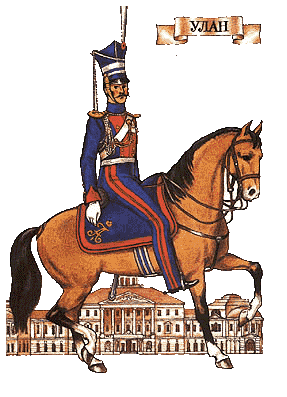 1. PRIVATE GRENADIER REGIMENT. 1809 Selected soldiers, designed to throw hand grenades during the siege of fortresses, first appeared during Thirty Years' War 1618-1648. Tall people, distinguished by courage and knowledge of military affairs, were selected for the grenadier units. In Russia, from the end of the 17th century, grenadiers were placed at the head of assault columns, to strengthen the flanks and to act against cavalry. TO early XIX centuries, grenadiers turned into a type of selected troops, not distinguished by weapons
1. PRIVATE GRENADIER REGIMENT. 1809 Selected soldiers, designed to throw hand grenades during the siege of fortresses, first appeared during Thirty Years' War 1618-1648. Tall people, distinguished by courage and knowledge of military affairs, were selected for the grenadier units. In Russia, from the end of the 17th century, grenadiers were placed at the head of assault columns, to strengthen the flanks and to act against cavalry. TO early XIX centuries, grenadiers turned into a type of selected troops, not distinguished by weapons
 A military uniform is not only clothing that should be comfortable, durable, practical and light enough so that a person bearing the rigors of military service is reliably protected from the vicissitudes of weather and climate, but also a kind of calling card of any army. Since the uniform appeared in Europe in the 17th century, the representative role of the uniform has been very high. In the old days, the uniform spoke about the rank of its wearer and what branch of the army he belonged to, or even in what regiment he served.
A military uniform is not only clothing that should be comfortable, durable, practical and light enough so that a person bearing the rigors of military service is reliably protected from the vicissitudes of weather and climate, but also a kind of calling card of any army. Since the uniform appeared in Europe in the 17th century, the representative role of the uniform has been very high. In the old days, the uniform spoke about the rank of its wearer and what branch of the army he belonged to, or even in what regiment he served.
His Imperial Majesty's own Convoy, a formation of the Russian Guard that protected the royal person. The main core of the convoy were the Cossacks of the Terek and Kuban Cossack troops. Circassians, Nogais, Stavropol Turkmen, other Muslim mountaineers of the Caucasus, Azerbaijanis, a team of Muslims, since 1857, the fourth platoon of the Life Guards of the Caucasian squadron, Georgians, Crimean Tatars, and other nationalities of the Russian Empire also served in the Convoy. Official founding date of the convoy
 From the author. This article provides a brief excursion into the history of the emergence and development of uniforms of the Siberian Cossack Army. The Cossack uniform of the reign of Nicholas II is examined in more detail - the form in which the Siberian Cossack army went down in history. The material is intended for novice uniformitarian historians, military historical reenactors and modern Siberian Cossacks. Pictured on the left military badge Siberian Cossack Army Unfortunately,
From the author. This article provides a brief excursion into the history of the emergence and development of uniforms of the Siberian Cossack Army. The Cossack uniform of the reign of Nicholas II is examined in more detail - the form in which the Siberian Cossack army went down in history. The material is intended for novice uniformitarian historians, military historical reenactors and modern Siberian Cossacks. Pictured on the left military badge Siberian Cossack Army Unfortunately,
Uniforms of the army hussars of the Russian Imperial Army of 1741-1788 Due to the fact that the irregular cavalry, or rather the Cossacks, fully coped with the tasks assigned to it in reconnaissance, patrolling, pursuing and exhausting the enemy with endless raids and skirmishes, for a long time in the Russian The army had no particular need for regular light cavalry. The first official hussar units in the Russian army appeared during the reign of the Empress
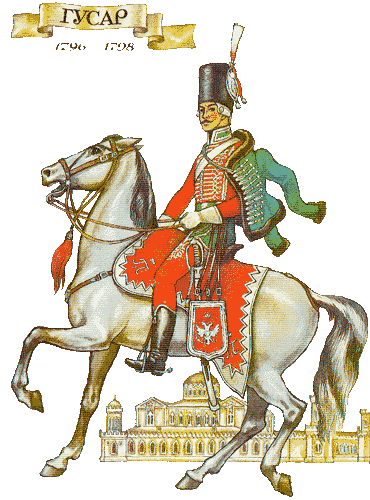 Uniform of the army hussars of the Russian Imperial Army 1796-1801 In the previous article we talked about the uniform of the Russian army hussar regiments during the reign of Empresses Elizabeth Petrovna and Catherine II from 1741 to 1788. After Paul I ascended the throne, he revived the army hussar regiments, but introduced Prussian-Gatchina motifs into their uniforms. Moreover, from November 29, 1796, the names of the hussar regiments became the previous name after the surname of their chief
Uniform of the army hussars of the Russian Imperial Army 1796-1801 In the previous article we talked about the uniform of the Russian army hussar regiments during the reign of Empresses Elizabeth Petrovna and Catherine II from 1741 to 1788. After Paul I ascended the throne, he revived the army hussar regiments, but introduced Prussian-Gatchina motifs into their uniforms. Moreover, from November 29, 1796, the names of the hussar regiments became the previous name after the surname of their chief
Uniform of the hussars of the Russian Imperial Army of 1801-1825 In the two previous articles we talked about the uniform of the Russian army hussar regiments of 1741-1788 and 1796-1801. In this article we will talk about the hussar uniform during the reign of Emperor Alexander I. So, let's get started... On March 31, 1801, all hussar regiments of the army cavalry were given the following names: hussar regiment, new name Melissino
Uniform of the hussars of the Russian Imperial Army of 1826-1855 We continue the series of articles about the uniform of the Russian army hussar regiments. In previous articles we reviewed the hussar uniforms of 1741-1788, 1796-1801 and 1801-1825. In this article we will talk about the changes that occurred during the reign of Emperor Nicholas I. In the years 1826-1854, the following hussar regiments were renamed, created or disbanded year old name
 Uniform of the hussars of the Russian Imperial Army 1855-1882 We continue the series of articles about the uniform of the Russian army hussar regiments. In previous articles we got acquainted with the hussar uniforms of 1741-1788, 1796-1801, 1801-1825 and 1826-1855. In this article we will talk about changes in the uniform of the Russian hussars that occurred during the reign of Emperors Alexander II and Alexander III. On May 7, 1855, the following changes were made to the uniform of officers of the army hussar regiments
Uniform of the hussars of the Russian Imperial Army 1855-1882 We continue the series of articles about the uniform of the Russian army hussar regiments. In previous articles we got acquainted with the hussar uniforms of 1741-1788, 1796-1801, 1801-1825 and 1826-1855. In this article we will talk about changes in the uniform of the Russian hussars that occurred during the reign of Emperors Alexander II and Alexander III. On May 7, 1855, the following changes were made to the uniform of officers of the army hussar regiments
 Uniform of the hussars of the Russian Imperial Army of 1907-1918 We are finishing the series of articles about the uniform of the Russian army hussar regiments of 1741-1788, 1796-1801, 1801-1825, 1826-1855 and 1855-1882. In the last article of the series we will talk about the uniform of the restored army hussar regiments during the reign of Nicholas II. From 1882 to 1907, only two hussar regiments existed in the Russian Empire, both in the Imperial Guard, His Majesty's Life Guards Hussar Regiment and the Grodno Life Guards
Uniform of the hussars of the Russian Imperial Army of 1907-1918 We are finishing the series of articles about the uniform of the Russian army hussar regiments of 1741-1788, 1796-1801, 1801-1825, 1826-1855 and 1855-1882. In the last article of the series we will talk about the uniform of the restored army hussar regiments during the reign of Nicholas II. From 1882 to 1907, only two hussar regiments existed in the Russian Empire, both in the Imperial Guard, His Majesty's Life Guards Hussar Regiment and the Grodno Life Guards
![]() There is a version that the forerunner of the lancers was the light cavalry of the army of the conqueror Genghis Khan, whose special units were called oglans and were used mainly for reconnaissance and outpost service, as well as for sudden and rapid attacks on the enemy in order to disrupt his ranks and prepare an attack on the main strength An important part of the Oglan weapons were pikes decorated with weather vanes. During the reign of Empress Catherine II, it was decided to form a regiment that seemed to contain
There is a version that the forerunner of the lancers was the light cavalry of the army of the conqueror Genghis Khan, whose special units were called oglans and were used mainly for reconnaissance and outpost service, as well as for sudden and rapid attacks on the enemy in order to disrupt his ranks and prepare an attack on the main strength An important part of the Oglan weapons were pikes decorated with weather vanes. During the reign of Empress Catherine II, it was decided to form a regiment that seemed to contain
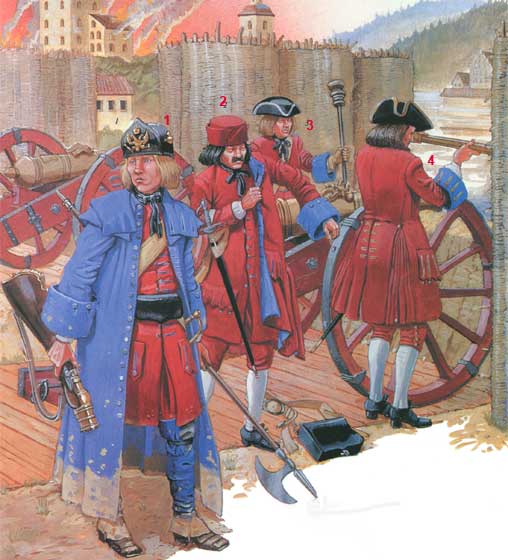 Artillery has long played an important role in the army of Muscovite Rus'. Despite the difficulties with transporting guns in the eternal Russian impassability, the main attention was paid to casting heavy cannons and mortars - guns that could be used in sieges of fortresses. Under Peter I, some steps towards the reorganization of artillery were taken as early as 1699, but only after the Narva defeat they began to do it in all seriousness. The guns began to be combined into batteries intended for field battles and defense
Artillery has long played an important role in the army of Muscovite Rus'. Despite the difficulties with transporting guns in the eternal Russian impassability, the main attention was paid to casting heavy cannons and mortars - guns that could be used in sieges of fortresses. Under Peter I, some steps towards the reorganization of artillery were taken as early as 1699, but only after the Narva defeat they began to do it in all seriousness. The guns began to be combined into batteries intended for field battles and defense
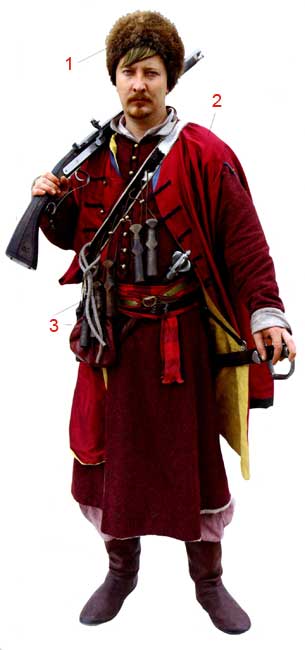 1 Don Ataman, 17th century The Don Cossacks of the 17th century consisted of old Cossacks and Golota. Old Cossacks were considered those who came from Cossack families of the 16th century and were born on the Don. Golota was the name given to first-generation Cossacks. Golota, who was lucky in battles, grew rich and became old Cossacks. Expensive fur on a hat, a silk caftan, a zipun made from bright overseas cloth, a saber and firearms - a arquebus or a carbine - were indicators of the wealth of a Cossack.
1 Don Ataman, 17th century The Don Cossacks of the 17th century consisted of old Cossacks and Golota. Old Cossacks were considered those who came from Cossack families of the 16th century and were born on the Don. Golota was the name given to first-generation Cossacks. Golota, who was lucky in battles, grew rich and became old Cossacks. Expensive fur on a hat, a silk caftan, a zipun made from bright overseas cloth, a saber and firearms - a arquebus or a carbine - were indicators of the wealth of a Cossack.
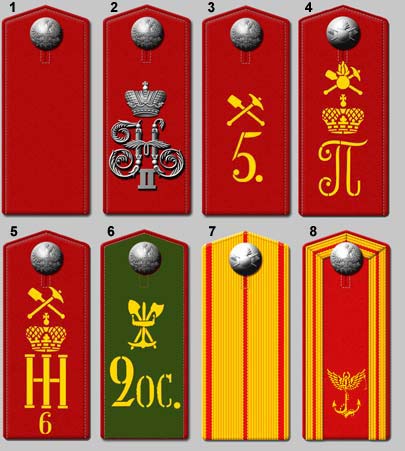 Military uniform is clothing established by rules or special decrees, the wearing of which is mandatory for any military unit and for each branch of the military. The form symbolizes the function of its wearer and his affiliation with the organization. The stable phrase honor of the uniform means military or generally corporate honor. Even in the Roman army, soldiers were given the same weapons and armor. In the Middle Ages, it was customary to depict the coat of arms of a city, kingdom or feudal lord on shields,
Military uniform is clothing established by rules or special decrees, the wearing of which is mandatory for any military unit and for each branch of the military. The form symbolizes the function of its wearer and his affiliation with the organization. The stable phrase honor of the uniform means military or generally corporate honor. Even in the Roman army, soldiers were given the same weapons and armor. In the Middle Ages, it was customary to depict the coat of arms of a city, kingdom or feudal lord on shields,
 The goal of the Russian Tsar Peter the Great, to whom all the economic and administrative resources of the empire were subordinated, was to create an army as the most effective state machine. The army that Tsar Peter inherited, which had difficulty accepting military science Contemporary Europe can be called an army at a stretch, but there was significantly less cavalry in it than in the armies of European powers. The words of one of the Russian nobles of the late 17th century are well known. Horses are ashamed to look at cavalry
The goal of the Russian Tsar Peter the Great, to whom all the economic and administrative resources of the empire were subordinated, was to create an army as the most effective state machine. The army that Tsar Peter inherited, which had difficulty accepting military science Contemporary Europe can be called an army at a stretch, but there was significantly less cavalry in it than in the armies of European powers. The words of one of the Russian nobles of the late 17th century are well known. Horses are ashamed to look at cavalry
From the author. In this article, the author does not pretend to fully cover all issues related to the history, uniform, equipment and structure of the Russian army cavalry, but only tried to briefly talk about the types of uniforms in 1907-1914. Those wishing to become more deeply acquainted with the uniform, life, customs and traditions of the Russian army cavalry can refer to the primary sources given in the list of references for this article. DRAGUNS At the beginning of the 20th century, Russian cavalry was considered
The corps of military topographers was created in 1822 for the purpose of topographic topographic and geodetic support of the armed forces, conducting state cartographic surveys in the interests of both the armed forces and the state as a whole, under the leadership of the military topographic depot of the General Staff, as the single customer of cartographic products in the Russian Empire . Chief officer of the Corps of Military Topographers in a semi-caftan from the times
At the very end of the 17th century. Peter I decided to reorganize the Russian army according to the European model. The basis for the future army was the Preobrazhensky and Semenovsky regiments, which already in August 1700 formed the Tsar's Guard. The uniform of the fusiliers of the Preobrazhensky Life Guards Regiment consisted of a caftan, camisole, trousers, stockings, shoes, tie, hat and cap. The caftan, see the image below, was made of dark green cloth, knee-length, instead of a collar it had a cloth collar, which
During the First World War of 1914-1918, tunics of arbitrary imitation models of English and French models, which received the general name French after the English general John French, became widespread in the Russian Imperial Army. The design features of the French jackets mainly consisted in the design of a soft turn-down collar, or a soft standing collar with a button fastener, similar to the collar of a Russian tunic, adjustable cuff width using
Arrows of the Imperial Family
The Imperial Family Rifle Regiment was created during the Crimean War.
Not to mention all tsarist army, and taking for comparison only the brilliant imperial guard, distinguished by the exceptional originality and richness of traditions of each of its formations, we can say that even against the backdrop of the last Arrows of the Imperial Family they differed sharply in everything: from their uniforms to their source of funding.
In October 1854, when bitter for the Russians Crimean War was approaching the final and the defeat of Russia was already obvious, Sovereign Nikolai Pavlovich announced to the Minister of Destinies that Royal family wants to send his own army to defend the Fatherland. On October 25, 1854, the “Regulations on the Formation of the Imperial Rifle Regiment” was published, which contained the following paragraphs:
§ 2 This regiment will be recruited from appanage peasants, mainly from the Novgorod, Arkhangelsk and Vologda provinces, where there are many skilled shooters engaged in animal hunting...;
§ 7 The uniform of the riflemen will be adapted to ordinary peasant clothing; they will be allowed to wear a beard;
§ 8 For the first time, each shooter retains his own hunting rifle...
It must be added that the regiment was formed on a voluntary basis and only for the period of hostilities. At the end of the war he was to be sent home. The money necessary for the formation and maintenance of the regiment was to be allocated from specific amounts, and the Minister of Appanages, Count V.A. Perovsky, was appointed Head of the regiment.
On January 16, 1855, the emperor approved the final description of the regiment's uniform and equipment:
The hat is dark green cloth of Russian cut, rectangular, lined with cotton wool, the width of the trim along the upper edge from one corner to the other is 4 ¾ inches, the height of the corner to the other is 2 inches, and the band is made of black smushka 1 ¼ inches high. On the front, on the band opposite the corner, a copper cross was sewn according to the approved pattern.
Half-kaftan of dark green cloth of Russian cut, without a collar, slightly open at the front at the seam. At the back of the caftan there are gatherings (folds). The caftan was fastened from right to left with six round gilded buttons and six loops of gold cord sewn on the right side. Cloth flaps for pockets were sewn on both sides of the semi-caftan. There is edging everywhere on the edges, except for the hem, on red cloth. From top to waist, along the edges of the bead near the piping, gold army braid is sewn in two rows, the first row to the bead is narrow - ¼ inch, the second - wide - ½ inch; The same braid is used to trim the lower edge of the sleeves, which do not have cuffs. The lining is dark green stamed. The length of the half-caftan does not reach the knees by 5 inches.
Bloomers of dark green cloth, in boots.
Epaulets made of gold thread with gold fabric on the field, according to the ranks of the army.
The scarf (in full dress, instead of a sash) and the lanyard for the hat are infantry army.
An ordinary officer's overcoat, with a gray collar and dark green flaps based on the Cossack pattern; officers - with smooth yellow buttons. In wartime, officers and class officials wear hiking overcoats according to the form approved for the lower ranks of the rifle regiment.
Red wool sash for girding a caftan and an overcoat.
Waist belt of the established type.
White suede gloves.
Boots with long tops, with red leather edging. The staff officers, adjutants, treasurer, quartermaster, doctor and auditor have spurs.
A dark green cap, modeled on the Jaeger army regiments, with a cockade, is worn on all occasions when officers of combat troops are allowed to wear caps.
Dragoon checker.
A dragoon-shaped sword belt, over the shoulder, covered with gold braid on black leather.
However, Tsar Nikolai Pavlovich did not have a chance to see his shooters. The formation of the regiment ended in June 1855 after his death on February 18. Therefore, the first Highest review of the regiment was held on July 1, 1855 by the new Sovereign, Alexander II.
The regiment was given a special elite status not only by the fact that the Emperor himself became the August Chief of the regiment and its 1st battalion, but also by the fact that all other battalions of the regiment received their August Chiefs in the persons of the brothers Alexander II - Konstantin, Nikolai and Mikhail; and also that all the men of the Imperial Family, including the Dukes of Leuchtenberg (Romanovsky), were included in the lists of the regiment. Neither before nor after this, never any part of the Russian army had anything like this. Naturally, there was no end to those wishing to serve as officers in such a regiment.
The selection of officers was entrusted to the Head of the regiment, Count Perovsky. The position of Junior Staff Officer of the regiment and the rank of lieutenant colonel was given to such a purely civilian person as the count's nephew, Alexey Konstantinovich Tolstoy. Not without the patronage of the latter, a number of civilians, relatives and friends of Count Tolstoy entered the regiment, for example, V.M. Zhemchuzhnikov, cousin of Alexei Konstantinovich and better known as one of the literary fathers of the immortal Kozma Prutkov. Alexei Konstantinovich Tolstoy composed the text of the cheerful song “Charochka” for the officers’ artel (meeting) of the regiment.
However, the regiment, although it managed to go to the theater of war, did not have time to take part in hostilities, standing until peace was signed near Odessa. According to the regulations on the formation of the regiment after the war, it should have been disbanded. But the Tsar, apparently, was sorry to exclude such a unique part from the army and he extended its existence, appointing it to participate in the act of the Holy Coronation in August 1856 in Moscow, and after this, “wishing to perpetuate the memory of the brilliant regiment,” the Highest was ordered to form on its basis a special Life Guards Rifle Battalion of the Imperial Family with the rights of the Young Guard. The battalion retained all the features of its formation, financing, etc., that the regiment had. As before, all men of the Imperial Family were included in his lists.
Changes in uniform in 1857.
1. Have a semi-caftan with a standing rounded collar and straight cuffs, the same color as the semi-caftan and with crimson piping on the collar, cuffs and along the edge of the left side to the bottom of the hem.
2. Discard the galloons for lining the sides and edges of the sleeves of semi-caftans.
3. On the collar and cuffs of half-caftans, have two buttonholes: for officers - embroidered in gold, and for lower ranks - made of linen braid, with a dark green stripe in the middle.
4. Without changing the cut of the soldier's overcoat, have a stand-up collar on it, the same color as the overcoat, with a small dark green flap, a button on it and with crimson piping along the edge of the collar and around the flap.
5. Shoulder shoulder straps, lining of officer's epaulettes, piping on the cap, sash, piping on the flaps of collars, officer's cloak and overcoat, as well as lining and piping on the general's cloak - have a crimson color.
How beautiful the uniform of the Imperial Riflemen was can be judged by the fact that in 1865 the Emperor ordered uniforms to be sewn for the two personal huntsmen of the Emperor and the Tsarevich, respectively, based on the uniform of the Life Guard Rifle Battalion of the Imperial Family. This was due to the fact that personal huntsmen, although they had permanent apartments in Yegerskaya Sloboda, lived most of the time in palaces, where their main responsibility was to care for the personal hunting dogs of the Sovereign and the Tsarevich. These huntsmen even received a special name - Indoor (Chamber-) Huntsmen. In the palace they wore a staff livery like footmen, but with green collars and cuffs rather than red. Under the livery was worn a baldric with a gilded device and a dagger, and on top of it a silver horn. Apparently wanting to distinguish the huntsmen from the crowd of palace lackeys and guards, but at the same time not considering it necessary to create a special uniform for just two people, and the wearing by the latter of a purely functional and not particularly beautiful uniform of the Court Hunt itself is not entirely suitable for their rank and palace setting, the Sovereign I found a simple and elegant solution. The uniform of the Imperial Riflemen was not only beautiful, but also in its origin was directly related to the clothing of northern peasant hunters. Personal huntsmen retained this feature of their form under subsequent Sovereigns.  A feature that quickly became a tradition not only of the imperial, but also of all guards riflemen in general, was over great shooting. Guards Rifle battalions, as a rule, fired “outside the ranks,” i.e. rating higher than “excellent”. For the lower ranks, excellent shooting was also a good incentive, because... In view of the huge number of prizes, ranging from Imperial and Grand Ducal prizes to those appointed by battalion officers, a lucky shooter could shoot himself an amount equal to 2-3 years of a soldier’s salary at battalion, brigade and all-army shooting. And examples of this were not uncommon.
A feature that quickly became a tradition not only of the imperial, but also of all guards riflemen in general, was over great shooting. Guards Rifle battalions, as a rule, fired “outside the ranks,” i.e. rating higher than “excellent”. For the lower ranks, excellent shooting was also a good incentive, because... In view of the huge number of prizes, ranging from Imperial and Grand Ducal prizes to those appointed by battalion officers, a lucky shooter could shoot himself an amount equal to 2-3 years of a soldier’s salary at battalion, brigade and all-army shooting. And examples of this were not uncommon.
This highest marksmanship training was confirmed by the Imperial Fusiliers on the battlefields of the Balkan campaign. With the order “Shoot only when you can hit,” the Riflemen in the attacking chains took Turkish fortifications with losses often 10 times less than the defenders! For this campaign, the Life Guards Rifle Battalion of the Imperial Family received the St. George Banner and the rights of the Old Guard.
Service in the Guards unit, and even more so in the Imperial Riflemen, was, of course, very prestigious and, most importantly, provided the opportunity to make a quick and successful military career. But at the same time, this service, which took place in full view of the Imperial Family, was very difficult and responsible. The officer's behavior, not only in the ranks, but also outside, had to be impeccable; there could not be the slightest stain on his reputation. His clothing and military bearing had to be impeccable. Sovereign Alexander Nikolaevich, like his father, could not stand a slovenly and dirty dressed officer, and even with poor drill bearing. And although Alexander Nikolaevich was in many ways gentler than Nikolai Pavlovich, who quickly became furious at the sight of the bungling officer, successful career such an officer would have been promoted to fat. And the memory for faces and surnames of both Nicholas I and Alexander II was exceptional.
The Imperial Riflemen received a practical and comfortable uniform, not only unlike the uniforms of the rest of the Russian army, but also sharply different from them. Even when Alexander III ascended the throne, who introduced a more uniform and practical uniform of the so-called Russian style into the army, even then the Imperial Riflemen retained all the features of their uniform, which distinguished them from other parts of the army.
- In contact with 0
- Google+ 0
- OK 0
- Facebook 0

